#to colonize all of kirby's work
Text

December 1988. Overall, the Jim Starlin/Mike Mignola COSMIC ODYSSEY miniseries is pretty awful — it has cool art, but, like most of Starlin's DC work during this period, it's gratuitously brutal and ugly, and both Starlin's offensive treatment of the Kirby Fourth World mythos and the senseless character assassination of John Stewart did lasting damage — but it does have its moments.
#comics#cosmic odyssey#jim starlin#mike mignola#carlos garzon#steve oliff#superman#lightray#new gods#batman#fourth world#john stewart#starlin has his own brand of cosmic stuff#but he does not get or respect the jewish underpinnings#of kirby's fourth world saga#i waver on whether it's worse than john byrne's determination#to colonize all of kirby's work#but it's certainly as bad#and dc's post-crisis determination#to recast darkseid as a superman villain#is troubling#superbat
5 notes
·
View notes
Text
the reason a lot of people largely unfamiliar with modern kirby go "forgotten land did X thing for the first time in kirby, it's so cool", even if it's often not the case, is not only because they probably barely played kirby, but also because forgotten land puts most of the series best qualities at the forefront the way no other game did.
big post follows where i ramble with comparisons to other games while highlighting what i think forgotten land did right.
first of all, it's very upfront about it's theming. and it's very important in how it stands out.
i ADORE kirby triple deluxe, don't get me wrong. and I LOVE the fairy tale theming of the game, but if you weren't *aware* that this is what the game goes for, it can easily fly over your head.
kirby is inherently whimsical series, so a lot of fairy tale-isms in that game don't stand out nearly as much as it was probably intended. it could've been easily remedied if the game framed itself as a "fairy tale" more rather than them keeping this subtle. similar to how classic paper mario games had storybook intros, for example.
star allies similarly has a big theme about friendship but due to various factors, it feels superficial at best or unnoticeable at worst. because a lot of aspects that theoretically could make it work are not highlighted enough.
if you don't have prior context of other games, it doesn't come across as this game celebrates friendships kirby acquired over the past 25 years of the franchise's existence and more like he's casually brainwashing them for his own cause.
i understand that with big amount of playable characters you can't possibly make unique animations for every single one of them to sell you on this idea, but if you can't handle the scope, then don't go for said scope.
jambandra cult's dark parallels to the franchise's main cast are likewise not highlighted enough because most of it is not shown via gameplay or cutscenes but through easy to miss pause screen text.
robobot and now forgotten land are partially so loved because it's very clear what's the overall theming of the game and it's stages is. in robobot it's funny robots, capitalism, industrialism, colonization. in forgotten land it's memories, responsibilities, nature, abandoned civilizations. it's not me just reaching, game is called "forgotten land" and part of leon's motivation (albeit when he was under id-f86's influence) is his frustration with being left behind by the former leading civilization of the planet, aka them up and leaving their responsibilities behind.
forgotten land stands so much to people because it gives it damn ALL to stand out by making every facet of itself being connected to underlying themes the game presents.
second, game goes out of it's way to SHOW the player what kirby is all about. it's not shying away from exposing the casual player to lore or the importance of post-game content. instead of only hinting that all of this stuff might be important, game demonstratively nudges you into the right direction, whether you were initially interested or not.
"the lore" is tied to the main secondary collectible. a gameplay element. if person playing the game is invested to 100% it, they will most likely try to collect them all and read all of the flavor text in the process. likewise, even if player is not interested in 100%-ing the game, they might be hooked by the flavor text itself and be interested what it has to say about other copy abilities, characters, objects.
previous modern kirby games didn't try to make you feel engaged with the lore the same way. sure, there were some benefits of the pause screens that FL can't replicate (we lost the classic type of flavor text where the final boss directly addresses Kirby and we hear their thoughts), but it's a small loss in grand scheme of things.
simply pausing the game to read the flavor text is not stimulating the same way as directly working to get it. it becomes more intriguing this way, RNG element ironically making it even more special when a figurine with especially juicy lore pops up.
similarly, post-game content was made explicitly all "canon" in FL. not entirely new concept, we had similar cases in "revenge of the king" in super star ultra and "heroes in another dimension" in star allies, but FL is the first game that actively encourages you to do more stuff after you did the main story. it literally baits you with the "to be continued" screen after the credits.
not only it helps the game to beat "it's short!" allegations by making it clear that even besides main story there's plenty of stuff to sink your teeth into, it also simplifies the importance of post-game modes too. there is no "what if scenario" or "parallel story" bullcrap. it's straightforward. "isolated isles" picks up where main story left off, "ultimate cup z" picks up where "isolated isles" left off.
and the last, but certainly not least, the characterization.
i will argue that forgotten land is the best kirby game since kirby 64 in terms of giving personality to the main cast. some people accused elfilin of being a little bland, and admittedly his personality is not as fun as, say, magolor or susie, but he's still likeable and fleshed out in his own way. we actually get a lot more dialogue from him than you might expect, he has a lot to say in the waddle dee town and he comments about various locales on the world map, even ones where he would be kidnapped during the main story.
likewise, bandana dee, meta knight and king dedede all got their moments to shine. this partially ties to flavor text being easily accessible, but due to said flavor text no longer being tied to SIMPLY boss fights, it means that their characterizations and side-plots can be expanded upon further. making their roles in the story feel more thought out than it might come across otherwise.
and even outside of that, each of them gets a shining moment that shows what are they all about. meta knight casually challenges kirby on a training duel and gives his all. the first fight we have with meta knight where he's not under some sort of mind control since squeak squad. bandana dee constantly reminds us that he's very much willing to help us and canonically accompanies us through out entire adventure even if we don't take him with us. king dedede, while brainwashed for majority of the game, gets to do single coolest and selfless act through his entire history of existence, finally putting final nail in the coffin of "dedede is a villain" crap.
forgotten land might not be the first game to do any of the things i just mentioned, but the presentation means EVERYTHING. forgotten land impressed a lot of people, left a strong impact, precisely because it had way better presentation than any kirby game that came before it. this is precisely why it resonated so much with so many different people and will continue to do so.
91 notes
·
View notes
Text
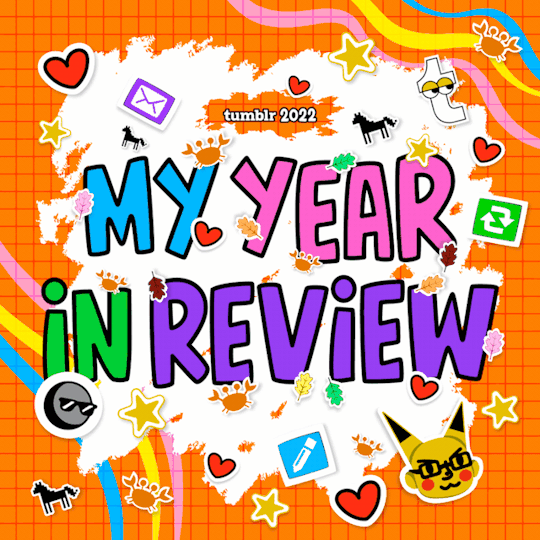
I posted 1,191 times in 2022
That's 1,188 more posts than 2021!
118 posts created (10%)
1,073 posts reblogged (90%)
Blogs I reblogged the most:
@browniefox
@rukafais
@poplasia
@rolkientolkien
@fluorescent-air-fresheners
I tagged 801 of my posts in 2022
Only 33% of my posts had no tags
#pokemon - 481 posts
#submas - 345 posts
#ingo - 297 posts
#emmet - 182 posts
#vee talks pokemon - 73 posts
#lmao - 68 posts
#wardeningopcau - 58 posts
#akari - 37 posts
#kirby - 30 posts
#sneasler - 27 posts
Longest Tag: 109 characters
#and as both an asian and a southerner this severely limits my beverage options at any given event or function
My Top Posts in 2022:
#5
Submas Longer Fic Recs pt. 1
In Tandem by yautjan
In which Arceus calls upon two pairs of twins to stop two doomsday plots simultaneously.
Ingo and Emmet are summoned to two different Jubilifes, to two different teenagers to aid them in their seemingly innocent journeys for reasons they do not fully understand. Dark machinations are at work though, and if everyone wants to get home safe at the end of the day it will take every ounce of strength, conviction and courage to brave the trials set before them.
Oh the Years have been Long by layren
Emmet and the world forget Ingo after he disappears, and some years later Sinnoh forgets Dawn. Nonetheless, they return, their own memories worse for wear. The Nimbasa Crew and Sinnoh Trainers combine forces, try to make sense of their lost memories and regain what's lost, and create a found family in the process.
Sought and Found by SakiStarling
When Akari was taken from her time, she was in the middle of something rather important. Now, things are even more dicey in a region that may or may not know her.
A Delivery Through Time by MCNixie
Emmet gets letters from 200 years ago via time magic. He is not having a good time.
Standard Operating Procedures by layren and pointvee
Who is Ingo? Who is Emmet? Who is Missing?
Unknown Tracks by StellarCoachman
In which no one told Emmet and Elesa that Ingo had time travelled, with some interesting consequences.
Detours by BrownieFox
Ingo and Dawn fall back into the future - and so does Rei.
(grabs the funny subway man) YOURE GOING BACK HOME FUCKER by Random_ag
In which Nimbasa City's most prominent figures find themselves in grief, a man and a child emerge from the mountains, and Ingo grapples with a world he would swear he knows, but cannot recognize.
Next stop, the place once called home by shadow_oblivion
the joltik fic, where Lady Sneasler and Ingo fall back into current times, and almost die a few times
232 notes - Posted April 30, 2022
#4
I can imagine that because it’s basically his diary he also records things that tick him off as well as important life events. He doesn’t upload anything for a while and then he posts a barely visible picture of a toppled over torch in a cave with “Goddammit Melli” written under the image, or whatever the pokemon equivalent of goddammit is
"Sinnoh above Melli this is the fortieth time this month"
others include:
[a shot of a large pile of torches, whose design is distinctive to pre-colonized Sinnoh] "Lady Sneasler was kind enough to help me gather all of the torches"
[a shot of a trail of torches leading the way through a cave, with a barely visible purple claw on the border] "All Safety Protocols have been Restored!"
[an extremely blurry shot of a frightened man in blue being bowled over by a blur of purple fur] "YOU."
260 notes - Posted April 11, 2022
#3
im surprised no one has eeby deebied the funny train men in marvel new york
ingo and emmet as villains of the day but theyre really just renovating the subway and making all the train run on time
or maybe just emmet while ingo has fun in hisui
tony stark having to deal with an unknown energy drain. emmets joltiks have coincidentally found a new favorite snack. emmet is also missing several joltik. the two collide.
spiderman meets joltik??? wait doesnt miles morales also have electric powers
something about the tesseract. maybe it summons palkia by accident
idk theres so many ideas to be had here
302 notes - Posted April 3, 2022
#2
more additions to the ingo on social media post i had:
im yoinking an idea from @cell113 with permission to fix my plothole, ingo thinks he’s like. posting these pics to a gallery. he’s using it kinda like a diary, where he can store his memories? he’s got plenty of pictures but its like scrap booking only the best/most important get put in the gallery. this means that unless something eventful happened 80% of his early posts are sneasel pics or landscape pics because,, he’s on a mountain. aint much up there. the point is he doesnt know other people can see what he’s posting.
anyways one of the first pics to break the wholesome trend (it also breaks the daily post streak ingo has kept up) is an extremely blurry picture of a figure in what can barely be recognizable as a white subway master coat, albeit ripped and tattered. theres what might be blood smeared across it??? the face is too blurred to make out as they loom over the camera, but theres a fanged smirk just barely visible. the caption is simply it looked like me. why was it smiling?
his followers are... understandably freaked out. theres a lot of concerned comments (that ingo cant see because he never figured out the show comments button lol) asking if he’s ok. he’s. mostly okay, just mild lacerations there are a lot of @’s toward @/submasemmet asking “Is this you?????”
and so emmet finds out about this very odd account.
(the mods on the site try to take to picture down a couple times for content violation, yknow. blood lmao. ingo keeps reposting it, worried that his diary is glitched, which increasingly confused captions like
this is my fifteenth time posting this why is it disappearing
is this device glitching?
before the mods give up attempting to contact him to stop and just spoiler warning his photo lol. theres a whole reddit thread compiling his captions though, and it is becoming slowly apparent that something is wrong with this account.)
313 notes - Posted April 8, 2022
My #1 post of 2022
ive seen a few akari has internet on the arc phone posts but hear me out:
ingo, his divine xtransceiver, and moderated social media
moderated so he doesnt break the time line ofc
it starts after the inital fuss of ingos fall into hisui, after being rescued and be selected as Lady Sneaslers warden. when the dust settles, ingo finally has time to look at the belongings that came with him. the odd watch like device he had that doesnt tell time he sets aside at first, its original position taken by the warden bracelet that is a sign of his position. but somehow its face flares with light, and it is transformed, slightly. golden lines and white planes replace black and red faces, and what he had assumed to be blank instead shows... him?
anyways he figures out it take photos! and the first post (why he’s posting and how he knows how to post is handwaved pls, idk myself lol) is a verrrrry close up photo of his eye. the handle is wardeningoPC which i bet would confuse some people on what the PC means. pokemon center? pokemon coordinator? (its pearl clan)
the account starts small back in the future, mostly pictures of the mount coronet landscape at different times, with captions in a weird mix of galarian and old sinnohan. the posts garner a small following, some rather concerned when ingo posts a picture from lady sneaslers cave of the raging blizzard outside. ingo can see the comments, mostly, but doesnt tend to reply. anyways he takes alot of these pics, and they look really nice. divine cameras have really nice resolution yknow
and then lady sneasler has kits. and what else would he want to take pictures of after that?? the people in the future are going absolutely bananas because this random guy is posting pictures of a completely extinct variant of pokemon, and babies at that. this is where the moderation comes into effect, as research inquiries, bribes, and even threats flood the account wanting to know about/obtain these rare mons. ingo sees none of this, most explicit mentions of the future are removed anyways. not sure if that moderation can be seen in the future though? ingo replies so rarely people would be unable to tell what he sees and doesnt see anyways
the sneasel pics skyrocket the account to internet fame in a week. people are speculating on who the account belongs to, what kind of pokemon are shown in the photos, where the owner is, etc.
(mmm i have more thoughts but thats for later i think)
686 notes - Posted April 7, 2022
Get your Tumblr 2022 Year in Review →
#tumblr2022#year in review#my 2022 tumblr year in review#your tumblr year in review#i miss pokemon posting
5 notes
·
View notes
Text
RoleSwap Challenge 1!
1/2/3/4/5/6
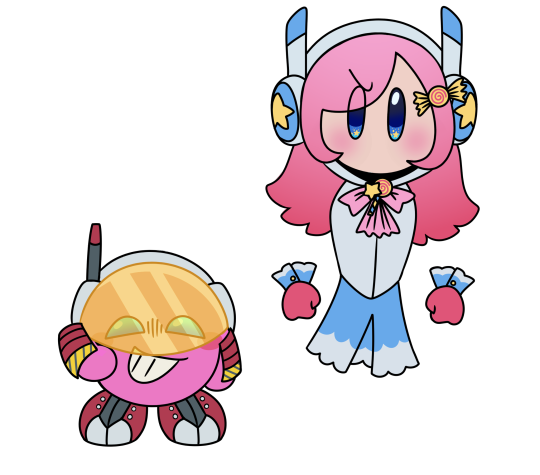
guess who found a random kirby character generator and decided to go wild? Feel free to try and make your own universes lol, I already have six planned out, so prepare for posts of them once I finish the swap designs!
Here are some rules i set up for myself, if any of you decide to do this challenge, following them is optional! I just set these up as some guidelines:
1. Each roleswap pair has their own universe, they don’t all overlap.
2. Characters do not swap abilities (unless specifically needed for anything to make sense, for example: a Magolor and Star-Dream swap), only personality, morals, and goals to some extent.
3. Characters swap places in the timeline, for example, swapping Marx and Magolor would mean in their universe Magolor would first appear in Kirby Super Star, and Marx in Kirby’s Return to Dreamland.
4. Only use main characters or bosses
uhh i think that’s it! this universe’s story is under the cut!
Susie and Kirby:
- Susie arrives on popstar with the intent to educate the populace, with Haltmann Works Co being a lot more helpful than hurtful. Her extensive knowledge of technology gives her many advantages, and soon she finds herself as a protector of the planet, especially with the use of her mech, as well as Star-Dream for much bigger threats.
- Kirby comes to dreamland diguised as a hero.. but really he wants to slowly gain the trust of the citizens so he can begin to colonize it for his home planet, which is in charge of a sort of intergalactic empire. idk. don’t ask too much about this i only have the concept planned lmao. Considering the rules of these universes, this may be where thing end for Popstar. Given the fact Kirby’s beaten Star-Dream in the normal universe, he might remain unbeatable and Popstar would fall to ruin. A universe where Kirby, a defeater of eldritch gods, becomes a villain is one with hardly a chance of a happy ending
#kirby series#kirby nintendo#digital art#kirby#susie kirby#susie haltmann#susanna paytra haltmann#roleswap#kirby au#my art#kirby planet robobot#kirby’s dreamland
86 notes
·
View notes
Text
𝘍𝘐𝘟𝘌𝘋𝘋𝘈𝘞𝘕 𝘈𝘜- 𝘏𝘌𝘈𝘋𝘊𝘈𝘕𝘖𝘕𝘚!
-------------------
1.) Edward absolutely gives Bella all the mind-tea at functions they attend, he's trying to get her to snort laugh, but it also entertains him. They also play matchmaker in the high schools they attend.
2.) Bella and Emmett are the CHAOS TWINS. They are banned from using fireworks without spousal supervision because one time Carlisle caught them shooting bottle rockets out of Emmetts ass crack.
3.) Bella sends Edward surrealist and bizarre memes without context all the time as well as memes like "then perish" and never explains any of them, forcing him to google them. Edward is so fucking confused sometimes.
4.) Emmett, Jasper and Bella have smash tournaments on their switches. They get loud. Emmett ONLY mains Little Mac, Jasper mains Samus, Bella mains Kirby and Sonic.
5.) Alice coordinates Esme, Rose and Bella for every function to ensure they are the baddest bitches in attendance. Sometimes Bella texts Leah so she walks in to be the BADDEST BITCH.
6.) Leah and Bella became friends by bonding over the whole "fucked over by a supernatural Ex thing.
7.) Leah is an underground kickboxer and taught Bella how to fight when she was human. Bella invited her on girl days with Angela, Jessica and Becca, Angela's (Trans) girlfriend.
8.) Rosalie calls Edward a colonizer as often as she can. He hates it, but accepts it.
9.) Edward is super secure in his masculinity and embraces his metro when he marries Bella. Tbh they can be kinda catty, but they're hilarious about it.
10.) Edwards roasts are God Tier.
11.) Emmett is actually really smart, he focuses on psychology and psychiatry. He is also a Himbo, and is full of love. He helps Rosalie process her trauma, and catalogues her triggers to ensure she avoids them.
12.) Emmett will go to frat parties literally just to watch girls drinks (and play beer pong).
13.) Emmett, Alice, Jasper and Edward were all at Stonewall, quietly using their bodies to protect protestors from projectiles. Emmett threw a brick at a cop. Jasper discovered he was Trans and received support there.
14.) The Cullens go to pride every year. Carlisle and Esme set up under a rainbow tent beside a space heater, and give out mom and dad hugs. Carlisle practices Gender affirmation surgery and provides resources and pamphlets on sexual health, gender dysphoria, and help to LGBTQ youth. He also holds panels for parents of LGBTQ children in order to help them better understand their children.
15.) Emmett is either in full drag or a zentai suit and a tutu causing chaos and having THE BEST TIME.
16.) Edward is gifted a small Demi-sexual pride flag from Bella, who is Panromantic Demi-sexual. He shyly, but happily carries it while he holds her hand. Bella's t-shirt says: "Still not Hetero."
17.) Alice outdoes her look every year. She is always getting her pic taken, Jasper helps get her angles right. She LOVES pride.
18.) Eventually the Pack comes too, Bella, Jacob, and Emmett get into all of the trouble.
19.) Quil imprinted on a man, when he thought he was straight. It was a massive shock, and he was terrified to tell the pack, but they're his bro's and love him to death. They happily welcome his new partner into the family, he and Quil are very happy.
20.) Angela marries her Girlfriend Becca, Bella is a maid of honor and bawls during her speech, she loves her friends very much. Angela goes on to be a Vet and Becca becomes a family practitioner. They live happily ever after.
21.) Rose and Bella are the sisters who will tear each-others throats out but if you come for one of them they will tear you apart. They can go from catfight to gossiping together in 5 seconds.
22.) Emmett, Jasper and Edward are genuinely terrified when they see their wives plotting quietly.
23.) Every Cullen man has at least one setting, and it is "Loves Wife."
24.) The couples roast other couples who treat marriage like a "ball and chain." There are a lot of "Are the straights...okay?"
25.) Esme is actually the master strategist of the family, and is brilliant when it comes to computing in her head. During the newborn war, she worked alongside Sam to plan the attack, Jasper helped with information.
26.) Esme can nail someone perfectly with La Chancla from 200 feet away. Bella is terrified of Esme when La Chancla comes out.
27.) The whole family learned Hindi, Spanish, French, Creole french, and Afrikaans to participate in each others cultures authentically and respectfully. They all love bollywood and watch with Rose whenever she puts something on. Bella and Rose get really invested in Telenovelas and Desi Dramas.
28.) Bella calls Edward Pandejo sometimes.
#There are so many more#I have so many thoughts#I'm tired of the Cullens being so fucking BORING#twilight#edward cullen#midnight sun#bella swan#fanart#dork#twilight renaissance#bella is black#twilight meme#oc#HEADCANONS#fixeddawn#carlesme#carlisle cullen#esme cullen
194 notes
·
View notes
Text
• X-Men is about civil rights. If you didn’t get that, you didn’t get X-Men.
• Black Panther is about colonization. If you didn’t get that, you didn’t get Black Panther.
• Captain America literally fought nazis. He is the embodiment of fighting the alt-right. If you didn’t get that, you didn’t get Captain America.
• The Empire in Star Wars is fascist. The Rebel alliance are Anti-Fascist. If you didn’t get that, you didn’t get Star Wars.
• Doctor Who was about an alien fighting for all of humanity in spite of totalitarian regimes. If you don't get that, you don't get Doctor Who.
• The Punisher isn’t meant to be a role model for police or armed forces. So much so that the writers of The Punisher made him actively speak out against it in a comic. If you didn’t get that, you didn’t get The Punisher.
• Deadpool is queer. He’s pansexual. Fact. If you didn’t get that you didn’t get Deadpool.
• Star Trek is about equality for all genders, races and sexualities. As early as the mid-60s it was taking a pro-choice stance and defending women’s right to choose. One of its clearest themes is accepting different cultures and appearances and working together for peace. (It’s also anti-capitalist and pro-vegan). If you didn’t get that, you didn’t get Star Trek.
• Superman and Wonder Woman (and a whole host of other superheroes) are immigrants. The stance of those comics is pro-immigration and pro-equality and acceptance. If you didn’t get that, you didn’t get Superman or Wonder Woman.
• Stan Lee said, “Racism and bigotry are among the deadliest social ills plaguing the world today.” If you’re bigoted or racist, you didn’t get any of the characters created by Stan Lee, Jack Kirby, Steve Ditko, and the rest of the Marvel Bullpen.
• The stories we grew up with all taught us to value other people and cultures and to treasure the differences between us. Only villains were xenophobic, or sexist, or racist, or totalitarian. I can’t understand how anyone can have missed that.
• If you’re upset that there’s a black Spider-Man, or a black Captain America, or a female Thor, or that Ms. Marvel is Muslim, or that Captain Marvel was pro-feminism or any of the other things right-wing “fans” say is “stealing their childhood” - you never got it in the first place. The things you claim are now “pandering to the lefties” were never on your side, to begin with.
If you consider yourself a fan of these things, but you still think the LGBTQ+ community is too “in your face”, or have a problem with Black Lives Matter, or want to “take the country back from immigrants”, then you’re not really a fan at all.
Geek culture isn’t suddenly left-wing... it always was. You just grew up to be intolerant. You became the villain in the stories you used to love.
(Copy and pasted from FB)
#equality#equal rights#pro lgbt#pro blm#pro women#pro choice#civil rights#left wing#anti sexism#anti police#anti discrimination#anti pro life
27 notes
·
View notes
Text
I swear I can't have fic ideas without them turning into Perfect Unity story ideas.
I just had an idea for a BNHA × Kill la Kill crossover story where Satsuki and Ryuko have quirks based around Life Fiber Manipulation (Satsuki is better at Creation, Ryuko is better at Destruction, but both can generally do the same things), and then it spiralled into a "You know who else has Fiber-like magic? Error Sans." And I said "God damn you're right, so does Muffet." And the Undertale Multiverse joined the mix in a way.
And then I said, "Well, the Undertale Multiverse's magic comes in a wide variety of forms, and the Gaster Blasters are kinda similar to the Galick Gun and Kamehameha techniques, so we can reanalyze the Ki of Dragon Ball as general Energy Manipulation magic, adding in Transformation and Fusion techniques somewhere in the Magic System."
And Dragon Ball is full of Aliens, and thats what Life Fibers are too. If you say that Life Fibers work like the Lekgolo (Hunters, Scarabs) from Halo, you might as well just add some more aliens into the Universe while you're there.
Aliens expands into Star Trek, so you shift the timeline of events around so that Humans achieve Warp at a more reasonable time (Solar Colonization and Terraforming of the Local System are going to take a Long Time, Warp would probably be on the Backburner for a while while we make Lunar, Martian, and Venusian colonies, figure out what to do with Mercury and Ceres, and then deal with Impulse Drives and the Outer Solar System) and Star Trek Voyager's EMH, plus the Magic System we've already made a thing, expands into the Steven Universe Gems being easily Possible.
And what are BNHA Quirks but super specialized Magic? If we rope in Megaman Starforce's Wizards (think of Dark Shadow and you're basically there), we can say that all Quirks are bound to a Companionate Spirit, call it a Wave, and give every Human their own Dark Shadow basically. You can pull something similar with the Stands from JJBA.
You want to cut down how many aliens you have a little bit? Just add the Dead Space Necromorphs and you have a good reason to lower your species numbers by however many you want. You want to Add Species? The Undertale Monsters can be recontextualized as Aliens, and you can do something like make Mezou Shouji and Muffet related or something another. Hell, you can even add Kirby and the Dark Matter species by calling them Amoeboid Cosmozoans and you're basically set. Star Trek's Data, the Voyager EMH, and the D'Arsay from the TNG Masks episode basically give you free reign to add robots and Aperture Science or something like it because again, why not?
I almost guarantee I have something interesting here, I just need to clean it up, shift some things around, and blend it together so the ingredients are more of a cake than a breakfast.
And I shall call it Perfect Unity, a world made of the Perfect Union of countless others into it's own identity, where anything is possible.
#cosmic speaks#undertale#undertale au#steven universe#bnha#bnha dark shadow#megaman star force#star trek: voyager#star trek#star trek: next generation#kill la kill#error sans#dragon ball#halo#kirby#dark matter#perfect unity
16 notes
·
View notes
Note
heyyy, hope you’re having a good night!! if you have the energy and feel okay answering, what’s up w taz graduation? i haven’t checked it out yet but i was thinking ab it. just asking bc you’re the first person i saw talk ab the show having serious issues, but also feel free to not answer this!! hope you have a good week!
i took a nice hot bath, had a strawberry kiwi capri-sun, and did a nice face mask and i’m feeling pretty good - so, y’know what anon? let’s talk about it.
for anyone who likes taz grad who sees this post: it’ll be tagged with “taz grad hate” (although i feel hate is definitely a very strong word - it’s for the simplicity of tagging it) - so please block the tag if you don’t want to see this post (especially because i put a readmore on a post before and it didn’t show up on mobile and instead gave the full post). mobile tumblr has a tag blocking system, so please feel free to use it! i don’t mind haha
anyway, so this is... probably going to be a lost post, and i wanna go ahead and preface it: this absolutely isn’t any hate on the mcelroys themselves. i love the brothers and their dad a lot, and while i doubt any of them would ever see this (or have it sent to them, or shown to them, because im pretty sure they try to distance themselves from this sort of thing), i just want to make it clear that criticizing a product is different than bashing a person. which brings me to the point of if i do end up sounding as if im bashing someone - please call me out on it! it’s not my intention to target anyone.
with that said, let’s talk about this campaign.
so my problems are as thus: the railroading, the shipping (a fandom problem, but it’s present in the podcast), the NPCs, and some misc problems others have addressed better than i have.
which. i know. that’s basically the entire podcast. (i promise i’ll bring up some positive points to balance it all out). keep in mind i’ve only personally listened to... what, six episodes? and it was enough for me to drop it. some people dropped it first ep, some dropped it ep four, and others are still forcing themselves to listen.
the railroading
there was a time i could handle travis and his railroading [making sure the story goes exactly the way he has planned], because it was the very beginning of the podcast and that’s what you can kind of expect from a plot-heavy podcast. hell, i wouldn’t mind it if the interactions and goofs weren’t a huge part of why i listen to TAZ in particular (which, by the way, is why amnesty still stuck out to me - even if there was a direction griffin wanted to push them towards, the interactions between the players (or players and npcs) made up for any railroading). it’s kind of hard to not railroad a little when it’s story-heavy and you’re trying to built up a world that you’ve put a lot of thought into. however, a huge part of d&d is the spontaneity.
it’s kind of why i think balance was so popular. while there was railroading towards the end, there was the presence of improv that made it all good. most mcelroy content is enjoyed because of the goofs. the magic brian moment is memorable. the jenkin’s fight still stands out because it was funny (albeit a result of some bad rolls). the boys teasing angus sticks out because the four would play well off of each other. even without that - griffin had talked about how he had to roll with things (the fact he had planned for a fight atop the train, but ditched the idea for what his family members came up with instead). even in amnesty, a couple moments that stick out to me still are ned with the jetpack taking out a pizza hut sign, and the scene with the water where jake was trapped inside. they aren’t as fun, but they still stand out as “things i didnt expect to really end the way they did.”
with grad, it’s just. one after another. the thundermen want to subpoena a xorn? cool, let’s run with that until actually the xorn gets fed rocks and goes home and who cares about the subpoena now. fitzroy wants to keep his cloak? lets talk about it for a while and you also get no rolls to even try to keep it. fitzroy goes to meet higglemas in his office? oh, why are you here fitzroy? im going to keep asking you until you answer fitzroy? you arent getting out of this scene until you answer me, fitzroy, so just tell me why you’re here already, alright, fitzroy?
and even later in a episode i read a transcript of: hey argo, remember how you have this whole secret motivation? fuck you, im gonna talk about it here in your dream and reveal it to listeners and remove any tension you had building up, and you dont get a choice to talk about it because this all-knowing villain knows all about it :)
and even NOW in the latest episode, there’s a comment that “we should cap argo’s skills here” instead of just... making the checks higher. rogues are good at certain things and usually arent the best in battles. better hope argo never makes it to level 11, because who knows how people are gonna handle the fact that he gets a skill that’ll make it so certain skills can’t have a roll below 10 (reliable talent).
(griffin, thankfully, calls travis out for that, but still - travis, why would you even imply that, considering you should be aware of how rogues work considering magnus multiclassed into rogue and you played one on tiny heist?)
and in the newest episode, their Big Bad chaos (which, god, i personally hate that name) straight-out says “dont do this” to the thundermen. travis tries to say, on twitter, “a character saying “dont do this” is different than me saying it” but i need to point out that it’s one thing if you’ve said “no” in character but worked with the PCs doing otherwise, but the railroading says differently.
the shipping
ill try to make this quick, because it’s nothing to do with the fandom (ship however you want, man) - but i really feel the need to draw attention to this.
fitzroy, as confirmed by griffin in a ttazz episode, is asexual. not aroace, but ace nonetheless. and i find it... troublesome that the idea of rainer and fitzroy having a relationship is still pushed nonetheless, despite the fact that fitzroy (to my knowledge) was never once shown to reciprocate any feelings. not to be that person, but i really hope that grad doesnt have any sort of romantic relationships in it (at least - not between NPCs and PCs unless they’re actually like... warranted?).
i dont know, man. one of my closest friends is ace, and i know she wants a relationship, but i think it would reassure her a lot to see an ace character who isn’t pushed into one in case she ever changes her mind. someone once mentioned that they hope fi/tz/ra/in doesnt happen because theres relationships that have that “oh, you can just date” and it goes upwards there to “oh, you can have sex just to please them <3″ (which, to be honest, is kind of a gross mindset - if someone isnt interested, they arent interested).
also, uh, the TTAZZ where griffin states this, there’s kind of the mention tht the whole sexuality question was posed in relation to the episode “creative thinking” (the dream one i mentioned earlier) - which. uh. i don’t know if anyone caught this, but... rainer straight-up wrote fitzroy a letter in the dream like “are you going to accept my proposal? a girl doesn’t like to be left waiting” which. leaves me with some gross feelings because uh.
if... if the whole thing about fitzroys sexual orientation was addressed here, then why would you push your ship anyway? feels kinda iffy, man.
to which i want to say: fitzroy can date. he’s allowed to date. griffins allowed to do whatever he wants with his character. but when a lot of the flirting is met with nothing, i’m not gonna see the chemistry there. just because travis ships it doesn’t mean it’s canon.
the npcs
ah yes. lets talk about the npcs.
there’s... a lot. a lot a lot. i think travis trimmed down how many were present in a scene, but uh. there’s still a lot. and... uh... i kinda wish there wasn’t?
look, i know im going back to balance/amnesty, but just. hang in there for a moment. chill with me. vibe.
balance didnt have too many NPCs present at all times in each mini-arc. gerblins had some big names like barry, klarg, gundren, killian, yeemick, and magic brian. rockport limited had angus, jess, graham the juicy wizard jenkins, and all of the tom bodetts mentioned.
amnestys first arc had mama, barclay, jake, dani, pigeon, kirby, minerva, and that was about it for like. big names? and not all of them were present in each scene.
in the first episode of grad alone: gary, hernandez, jimson, rolandus, zana, rhodes, buckminster eden, rainer, leon, tomas, hieronymous, higglemas, stuart, jackle, bartholomeus, mulligan, groundsy, germaine/victoria/rattles (the skeleton crew). and those are the ones i wrote down (minus groundsy, who i just. ignores. idk him).
like holy shit, my english prof got onto me for having too many characters in my first chapter and i didnt even have half the amount listed there!
it’s just a huge cast. does this take place in a school? yes! theres bound to be a lot of students present - but you don’t have to name every single one of them, at least not in the first episode!
the miscellaneous
i don’t know if travis ever actually addressed it, but wheelchair users have actually like... said that rainer’s introduction bothered them, because she was like “please ask me abt my wheelchair :)” when travis saying she was in an ornate chair would have sufficed.
uh. the colonization vibes people have discussed within the centaur arc. mentioned here, the replies here, and this post (and its replies) here as well.
the overall lack of d&d when the campaign was kind of advertised as a return to d&d if i remember correctly
also no one seems to be taking literally any criticism at all which like. ignoring the petty shit, sure, but people have stopped donating to taz and their listener-ship must have dropped some during this entire time - you’d think that maybe someone could say “we need to find out why people dont like the thing and fix the thing” consider this is. yknow. their livelihood.
anyway uhhh
tl;dr: travis railroads way too much (even now), the shipping in-game has become pushy and gross (especially bc its shoving a relationship onto an asexual character), theres too many npcs that dont stand out well enough, and no ones taking any criticism about the major issues with grad.
#taz grad hate#taz graduation hate#Anonymous#ok im gonna go to sleep now goodnight#maybe ill wake up to hate tbh that'll be wild
5 notes
·
View notes
Photo
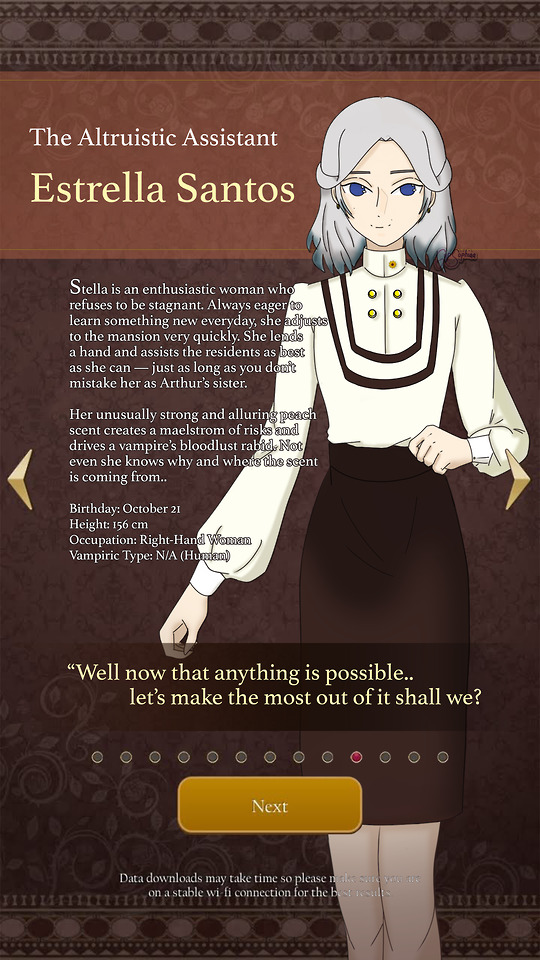

click for better quality!
don’t repost! reblogs appreciated (・ωー)~☆
meet Stella, my Blood Donation / IkeVamp Persona! more detailed description under the cut!
she's not that different from my Cradlesona, but i did change some stuff that are half true irl to make her fit well in the ikevamp universe. i mean i wish i can speak and understand several languages so i downloaded duolingo skskskksks
go make your own Blood Donation! Here's my lil reference you can use, I added some more details to fit in the story :) also, a big thanks to @trulipan for the inspiration of using the character screen!
*disclaimer: the character screen belongs to Cybird, the character info and sprite are fan made :)
Basic Info:
Nicknames: Stella, Sol (Leonardo), Peaches (Arthur and Comte)
Birthday: October 21
Age: 25
Height: 156 cm
Nationality: Filipina
Blood Type: A
Physical:
Eyes: bluish purple
Hair: gray platinum with bluish tips, short and wavy
Accessories: golden hoop earrings, sunflower pin (a souvenir she bought before arriving to the musee)
Features: beauty mark above her left lip, a fainter mark on her right cheek
Illnesses: sleep deprived (?)
Social:
Species: Human
Previous Occupation: Graphic Designer
Occupation: Right-Hand Woman (Assistant)
Relationships:
Arthur Conan Doyle, bickering writing buddy. They often get mistaken as siblings and it peeves them both. Stella dislikes his flirty and teasing personality a lot but she’s more than willing to lend a hand if he starts to run out of ideas (which is NOT her body). He loves to tease her and get her on her toes, which resulted to Sebastian lecturing him quite often. Ironically, they’re close friends
The Count of St. Germain, father-figure. They met when she accidentally dropped her sketch notebook. He complimented how she smelled like peaches and started calling her like that (which Arthur caught wind of and started teasing her for it). He spoils Stella rotten with chocolates, satiating her sweet tooth as much as possible to keep the smile on her face.
Leonardo da Vinci, language mentor. He was impressed when she understood what he was saying in Italian. Then tested her with Latin, German and Spanish. Stella was ecstatic to learn more languages causing his sly advances go over her head (much to everyone else’s relief). She organizes his room as best as she can as thanks.
Theodorus Van Gogh, mortal enemy but not really. He would always refer to her as “Arthur’s little sister” and it would often lead them to constantly bicker. However, both of them share the addicting love for pancakes and will eat it at any time of the day, this was one of the few times where they get along very well. Other times usually involve making Vincent happy and safe. Secretly, however, they look out for each other like actual siblings.
Sebastian, meme buddy. They converse in memes, confusing everyone else, when not too busy in work. She would often ask him historical facts about the others and appreciates him going the extra stretch (she likes listening to his history fanboying). He would also save her from Arthur’s teasing and Theo’s yelling, but sometimes he just stands at the corner and listen to them go mad because he finds it amusing.
Wolfgang Amadeus Mozart, radio (I don’t know how to call it HAHAHAHA). Stella would intentionally pass by near his room just to listen to him play the piano, reminiscing the time where she had a violin. It had always been her dream to hear a live, professional recital of one of his pieces, so hearing him composing new ones just beyond a door made her very happy. Mozart knows she’s listening.
William Shakespeare, neutral but very afraid. Stella avoids him as much as possible, his words are very confusing and deep but she tries her best to understand and remain kind.
Napoleon Bonaparte, older brother figure. He knows her unusually strong peachy scent would attract others and he dedicated himself to protect her. She's probably the most casual one to wake him up — Stella earned the free slap card when he tries to kiss her as thanks for endearing his habit.
Jean D'arc, stranger. She hopes to get to know him better. She would always see him with empty eyes and worries for him. She would often secretly pray for his happiness. Jean knows this.
Osamu Dazai, laugh pill. Though she often gets startled when he enters through windows out of nowhere, its followed by laughter she couldn't control. He likes seeing her laugh and it encourages him to never use the door (much to everyone else's dismay).
Isaac Newton, neutral. They don't speak much. Stella would smile his way whenever she sees him but often receives averting eyes in response and a mutter of hello. She would sometimes lightly hop in Arthur's teases about apples.
Vincent Van Gogh, lover. Stella admires his works since forever and to see him alive and well in person brought tears to her eyes when she realized that everything happening around her was real. Their relationship grew gradually, taking soft steps together until they realized they were in love. She would always sit near him when he's painting at the garden and play with his pet raccoon. She melts when he smiles.
Personality: Artistic and bubbly, she finds beauty in everything. Very expressive, but she keeps a facade when she's sad and it is quite difficult to pin out. She's more than willing to help anyone with whatever she can do. She is easily pleased with the simplest things and gets overwhelmed with gifts. She's usually quiet but if you spark a conversation with her it can go on for a long while, she likes to listen to stories and experiences. She loves to learn different languages and cultures. Can be smart then a dumbass the next moment. Underneath the innocent face is a sultry attitude that she's mastered to control and portray to catch people off guard — though she gets flustered easily when complimented.
Before the Visit to the Louvre: A fresh graduate from BA Multimedia Arts, she earned enough money from commissions to travel to famous museums and relax before starting her work on an international news media site.
Likes:
Chocolates
Adobong Baboy (A Filipino dish)
Pancakes
All the pets!!
Flowers!!
Dressing up!!!
Warm colors
Modern day jokes
Performing
Fruits
Dislikes:
Arthur
Skirt chasers
Being belittled
"Arthur's little sister"
Not knowing what is happening
Being stagnant (not doing anything)
Washing the dishes
Skills and Special Abilities:
Can understand several languages because of her constant travelling, speaks Spanish and Filipino very fluently.
Paints
Writes short stories
Can act like a completely different person if needed
Can go for three days without sleep or sleep for three days, no in between.
Inhales food like Kirby, her stomach has a void somewhere and she gets full very rarely.
Plays the violin (when she was a kid, very rusty today)
Paired with: Vincent Van Gogh
Life in the Mansion: On a daily basis, she helps Sebastian in his duties. Sometimes, she can be found talking business and assessing deals with Theo. She can also be seen in her room rereading Arthur's first manuscripts and editing them. When taking a break, she's sitting by the garden and having tea with le Comte, or watching Vincent paint. She would drop by the library an hour before bed to have a quick foreign language lesson with Leonardo.
Other Info:
She sings when painting very softly, especially when its raining where the pitter patter can drown out her voice.
Cries a lot in her sleep, mostly because of overthinking. She's gotten used to a life where she would be happy for one moment and devastated the next.
She bites. Metaphorically and literally. Arthur got hurt because of it one time.
Bribed easily with sweets — to an extent. She's not that stupid.
Always screams when surprised from behind while quickly whipping around to slap whoever jumped on her. She got a terrible childhood history with those kinds of surprises.
Slaps people by accident when she gets all panicky and will constantly apologize for such a rude habit.
Secretly very horny and has earned a PhD in self control. (Really makes you think that she's actually Arthur's long lost sibling)
She can't smell her peach scent which drives her nuts. A lot of people had told her that since coming in to the mansion. She's never even had peaches before.
The scent grows stronger after sex and bathing, which she found odd because none of the products she uses has peaches as an ingredient. She even uses a different perfume every time but the peach scent still somehow overpowers it.
Vampires are the only ones who can smell the scent, human don't.
Never touch her notebook. Ever. She's insecure about whatever notes and doodles she has. She's hidden it deep in her closet that even she herself forgets.
When questioned why she "doesn't look like a Filipina," she answers with deadpan eyes and a bored look. "We were colonized by the Spaniards for 3 centuries. My grandfather is Spanish." She's tired of being asked often.
Has acted for school plays all her life.
Laughs at everything.
Cries when mad, it adds annoyance to herself.
#now if only i was actually proud of this#im only happy about the layout tbhkjafaf#but the design of the character itself not so much#this may change still#especially the relationships#ikesona#blood donation persona#persona#ikemen vampire#ikevamp#ikevam#ikevamp oc#oc#イケヴァン#ikemen series
55 notes
·
View notes
Text
The Appropriation of African Culture: Its History and the Complexities of the Issue in the Present
Davonte Barksdale
Art of the Post Modern Era
05/23/2020
The systemic appropriation of African culture has been long standing and links all the way back to the enslavement and colonization of Africa by Europe, in the early 1400s. In Alan Kirby’s, Digitalism: Digimodernism: How New Technologies Dismantle the Postmodern and Reconfigure Our Culture, he discusses in great length how globalization, hyper capitalism, and technological advancement have shaped and complicated culture and society. Kirby attributes cultures fascination with autism and the increase in reported cases of autism to the response of accelerated advancements in technology and globalization.
These anomalies point toward a much more complex situation of cross appropriation in 2020, which John Welchman eludes to in his book, “After Appropriation: Essays on Art in the 1990s”. Between the 1400s, the start of Europe’s push in to Africa, and the present, there has undoubtedly been progress in terms of the Black community regaining freedoms, rights, and recognition for the community’s contributions, but society can still feel the traumas of the past. The appropriation of African art and music continues to this day and has evolved through dynamic, and swiftly shifting grounds.
The objective of the text is to bring attention to and expand on the ongoing conversation of the appropriation of Black Culture. Jacques Derrida provides his explanation of the exorbitant and how it can be utilized to clarify the interpretation of the sign. Derrida’s description for the exorbitant is everything outside of the canvas or framework. For example, he states in order to understand an author better, one would have to read not just all the author’s works, but also the works the author has read himself. Then Derrida takes the notion further by questioning if the authors shopping list is included in the text will it provide even more insight (Of Grammatology: The Exorbitant Question of Method)? In correlation, the idea is to explore unreached corners surrounding the appropriation of African culture and how today’s climate has effected the dynamics.
Three examples in the present were chosen to elaborate on the matter. To begin, the white South African hip hop group members of Die Antwood, are not strangers when it comes to controversy and being accused of appropriation. The dilemma surrounding the group stems from the fact that they are fair skinned and have profited immensely from African culture, yet they are still South African. What further complicates this example is the music video the group released in 2012 for the song, “Fatty Boom Boom” which contains an excessive amount of questionable material. There is an ongoing debate about the use of blackface and Klu Klux Klan garb in the visual and its context.
The second example of analysis is ten-time Grammy Award winning musician, Bruno Mars, who was thrown in to the spotlight over claims that the R&B and pop singer, song writer, and musician appropriates black culture in his music. Much of the angst is a product of how people identify the artist. Mars has a mixed background consisting of Jewish, Puerto Rican, and Filipino decent.
Last, self-identified homosexual and African-American hip hop artist, Lil Nas X’s anthem, “Old Town Road” and its ties to country music will be examined. Today, many Americans recognize that the genre of country music has developed into one of the biggest industries of music in the U.S. and a Caucasian dominated field. However, a deep dive into history reveals the roots of country music are well embedded in and were heavily influenced by African culture during the early times of European colonialism and slavery.
Before addressing these controversies, the definition of cultural appropriation, the history of European colonialism, and the enslavement of African people across the globe must be addressed. John Welchman defines appropriation in the statement, “Seen across one of its longest horizons, the term 'appropriation' stands for the relocation, annexation or theft of cultural properties-whether objects, ideas or notations - associated with the rise of European colonialism and global capital” (Art After Appropriation: Essays on Art in the 1990s, 1). While this text acknowledges the appropriation of black culture it is important to note that many other groups of indigenous people, like Native Americans, were also victims of appropriation and slavery.
In Robin Einhorn’s article, “Slavery”, from, the academic journal, “Enterprise & Society”, the author details how slavery played a major role in Europe and America’s early economy, and how that time period set the foundation for the way business continues to operate in present society. This is because the immense profits made from the chronic pain and hardships of African people were used to invest in the required capitals for many global industries that still exist today. For example, cotton grown and processed in Southern America was shipped and sold by mercantile organizations in Northern America. Einhorn adds to the conversation, “Labor historians have shown that slavery was hardly separate from wage labor when employers mixed slaves and free workers on their payrolls (usually paying the ‘wages’ of slaves to their owners) (494).”
The slave trade began as early as the 1400s when Europeans first began an aggressive push into Africa. Not too long down the road, slavery was introduced to America in the early 1600s. By this time, nations like Portugal, Brazil, Great Britain, France, Spain, and the Netherlands were also heavily involved in the shipping and selling of African Slaves (Hugh, Thomas, The Slave Trade: The Story of the Atlantic Slave Trade, 1440 – 1870).
Now that a brief history of slavery has been reviewed, the paradox of the South-African hip-hop group Die Antwoord can be assessed. The group of artists are of Caucasian ancestry, although they were born in South Africa. The performers of the group refer to themselves by the aliases of Ninja and Yolandi Vi$$er. Ninja was born in Johannesburg, while Yolandi Vi$$er was born in Port Alfred. It is significant that the group is Caucasian because it is a trait of Africa’s European colonizers that brought bloodshed and oppression to the homeland in the early ages of European colonialism. The use of white English in the region grew to become a staple of high business and commerce through the slave trade over the native Afrikaans language.
Die Antwoord has been criticized since the formation of the group in 2008. Most of the criticism is related to the groups use of paint, video editing, and juxtaposing black and white colored bodies to communicate racial and social implications. The group also sports golden teeth and tattoos, which are considered characteristics of American “gangsta rap”, a product of black American culture.
The group reached the height of its controversy at an international level with the release of a music video in 2012. Trouble began when American pop artist Lady Gaga asked Die Antwoord to open for the singer’s Born this Way tour in Cape Town, South Africa, as they share the similar theme of celebrating individuality. Not only did the hip hop group deny her invitation, they released the visuals for the song, “Fatty Boom Boom”, which attacked Lady Gaga’s image as a pop icon and symbol of America.
In the beginning of the video, a man in a blonde and blue wig is shown wearing what resembles the infamous meat dress, large sunglasses, expensive jewelry, and binoculars, implying the man is a representation of Lady Gaga. Gaga is shown as a foreigner in a tour bus visiting various sites and seeing stereotypical scenes of Africa from an American perspective that include hyenas, black panthers, and lions roaming the streets. The pop singer’s tour guide exclaims, “Over there is the king of the concrete jungle, The Lion King, Simba!” In the background on the walls are images of street art and graffiti depicting American music icons like Drake, Kanye West, Lady Gaga, Lil Wayne, and Nicki Minaj as a powerful, anamorphic, mythical beast wielding multiple phalluses and heads, and defecating on what appears to be white America.
Suddenly the tour bus is attacked and ravaged by local, dark skinned vigilantes in masks, wielding automatic rifles. Gaga is shown fleeing for her life and crying down the slums. As the song begins, an African man is shown wearing Klu Klux Klan (American white supremacist organization) like garb while playing drums, with words of positivity printed on its surface such as care, joy, love, respect, and hope. Then Yolandi Vi$$er joins the action, covered from head to toe in blackface and black body paint. To further problematize the dilemma, she wears a traditional South African dress and the size of her lips are accentuated to dramatize the western stereotypical view of African people.
Vi$$er can also be seen with big yellow contacts in her eyes. The pupils are shaped like dollar signs, implying the poverty ridden African people’s desire for economic prosperity or wealth, but also referring to the stylization of two dollar signs used in her alias as an artist, hence Yolandi Vi$$er. In contrast, the use of black paint and yellow contacts is also referencing the black panther shown in the introduction of the video. The Black Panther Party is a well known radical organization that has empowered African-Americans in the U.S. At the end of the video a black doctor delivers Gaga’s baby, which appears to be some kind of alien cricket. In the next scene she is devoured by The Lion King, Simba.
At first glance one’s immediate reaction is to quickly sum this performance up as hyper masculine, homophobic, transphobic, and of course, racist. Only after careful analysis of the material, frame by frame, will the viewer see the complexity and duality of the messages presented. The group is largely inspired by the South African counter culture movement known as Zef. Bryan Schmidt provides a description of Zef directly from the groups official website, in his article, “Fatty Boom Boom and the Transnationality of Blackface in Die Antwoord’s Racial Project,” which read at the time, ”Zef is a growing music genre (a variety of hip hop) and cultural movement predominantly among white-working class and Afrikaans-speaking South Africans.” The Zef movement is recognized as a counter cultural movement fueled by anarchic ideologies. It can be compared to other rebellious scenes around the world like grudge, underground street racing, and the hippie movement for example.
While it is understood the video is highly problematic and its execution is questionable, the consensus is the group’s intent through the use of reverse role play, rearrangement of symbols, and contradictions throughout the entire duration of the video is to critique the establishment, stereotypical western ideologies, and the perception of Africa in America. A similar technique of rearranging symbols to demonstrate new meaning can be observed in Fred Wilson’s deconstructive display, “Mining the Museum “, which is observable in Hal Foster’s book, “Return of the Real: The Avant-Garde at the End of the Century” (27).
Wilson accessed the archives of the Maryland Historical Society to find objects of interest and repositioned shiny silver metalwork’s with rusted slave manacles to critique the institution, class, race, and freedom. The metalworks clearly were not meant to accompany one another when they were initially produced. Wilson displayed these pieces together to change the sign and critique white patriarchy in the museum industry. Museums were notorious for maintaining works of white male interest and making those works readily available for viewing, while the works of other foreign nationalities or minorities were neglected and displayed in the back, or off to the side. The contrast in color and quality of the metal works spoke to America’s history of the division in wealth, liberty, and values in relation to ethnicity.
While, Die Antwoord may not present the best public image, they have found a niche in profiting through problematic methods of communication and controversy. The front end duo features a male and female performer implying gender balance and the need for both men and women. Lady Gaga specifically asked the group to join the Born this Way tour, which entailed a marketing plan and concept based on the unification of people from various backgrounds in terms of freedom, sexuality, woman empowerment, religion, and individualism. This implies Gaga’s team understood the entities shared an emphasis on individuality and being different. The purpose of the attack on Lady Gaga’s image was symbolic of America.
Bruno Mars’s forte is a fusion of R&B and pop music. R&B is considered black music, given the genre’s roots in soul. All ten Grammy Awards can be directly attributed to Mars’s signature blend of music. Today, the United States of America is recognized as one of the most diverse nations in the world and the rise of globalization as well as improvements in technology have facilitated racial ambiguity and the mixing of cultures on an international level. The United States of America is often called the boiling pot of the world. Some might even say America is going through an identity crisis and cannot keep up the rapid integration of various backgrounds (race, class, gender, sexuality, religion, etc.). In Rolling Stone’s article, “Bruno Mars: The Golden Child”, by Brian Hiatt, Mars discusses the troubles executives communicated when deciding which markets to target with the multiracial musician. Bruno Mars says, “They were talking about, ‘What radio station would play this?’ and it basically boils down to, ‘Who’s gonna buy your albums? Black people or white people?'”
As mentioned beforehand, Spain participated in the slave trade and also exported the indigenous people of Africa to the nation’s colonies in Central and South America, as well as many of the islands south of Florida, including the island of Puerto Rico. It is well documented in history that eastern invaders brought deadly diseases to the west like small pox, measles, typhus, and cholera that decimated the numbers of indigenous people living in the western hemisphere. There were not many indigenous people left for Spain to enslave, which lead the nation seek slaves for labor elsewhere, so Spain turned to Africa.
In 1534, Ascencio Villanueva, a San Juan lawyer, addressed King Charles V in attempt to obtain more slaves stating, “We cannot live without Black people (slaves) (A New Look at the African Slave Trade in Puerto Rico Through the Use of Parish Registers: 1660 - 1815).” Stark provides the baptismal records of slaves on the Island over the next few centuries to provide a better idea of how many African slaves resided. Over centuries, the supply sources of African slaves became increasingly more diverse. It is important to note that these records only catalogue slaves that were baptized on the island in select communities, and over time many records were lost or mishandled, implying there were in fact more slaves in Puerto Rico.
According to the baptismal record data of adult and infant slaves provided by Stark, a total of 27,008 slaves can be identified excluding slaves from the misplaced documents. To name a few sources, these slaves were shipped from all around the world including islands like Bermuda and Jamaica, as well as West Africa and West Central Africa. David Stark concludes by the time slavery ended in Puerto Rico, the slave population was so diversified it had a deculturalization effect which encouraged the integration of a unified Afro-Community within the colony, that continues to develop to this day.
Is Bruno Mars an appropriator? No, based on historical records or even DNA analysis it can be traced that African DNA is prominent within the Afro-Puerto Rican community. Bruno Mars has collaborated with many other Black or Afro-American artists over the course of his career including Travie McCoy, Cardi B, B.o.B, and Lil Wayne to build on and unify the culture.
Musician Lil Nas X reclaimed African-American roots in country music with his record breaking single, “Old Town Road”, officially released in 2019, which features a catchy reoccurring guitar loop. In the article, “Black Artists Built Country Music—And Then It Left Them Behind”, by Andrew Chow, he spotlights how the western banjo, an integral part of country music’s roots, was designed based on string instruments made and used in Africa.
Often associated with the rural Christian states of the south, the banjo came from modified, West African lutes brought over during the slave trade. Unearthed from the Oxford University Press’s archive, the article, “Banjo”, by Jay Scott Odell
and Robert B. Winans, refers to recent research describing, “Six traditional plucked lutes whose necks are made from a thick stalk of papyrus, and known throughout the Senegambian region by the Mande term ‘bang’ (also ‘bangoe’, ‘bangjolo’, ‘bangjulo’, ‘bung’, ‘bungo’).”
These instruments became an essential part of slave culture and music in the south, and were eventually stolen and appropriated by white colonial America. These appropriators even painted their faces black mocking African-Americans in the name of entertainment and propaganda during the Civil War, in the form of blackface minstrel comedy shows. In Randall Miller’s review of, “Love and Theft: Blackface Minstrelsy and the American Working Class”, located in, “The American Historical Review, Vol. 100, No. 5”, Miller writes, “Minstrelsy depended on currency as much as high stepping and banjo plucking to bring in paying customers (1658).”
In, “Black Artists Built Country Music –- and Then It Left Them Behind”, Andrew Chow refers to Ken Burns sixteen-hour documentary series, “Country Music”, which among many main arguments, supports the fact that, “Country music has always been home to African-Americans.” In the early stages of country music, also known as hillbilly music, technique and style was greatly influenced by negro slave spirituals, field songs, and religious hymnals.
Burns traces a hymn composed by a black prime minister called, “When the World is On Fire” and how it was rearranged into the Carter Family’s 1928 hit “Little Darling, Pal of Mine”. The latter grew to become Woodie Guthrie’s beloved American classic, “This Land is Your Land”. Black guitar player Leslie Riddle helped shape country music legends like A.P Carter from the Carter Family and Maybelle Carter with his innovative and fresh fingerpicking technique, but Riddle was eclipsed in no time by his fair skinned counter parts.
Furthermore, by the 1920s, hillbilly music became a mainstream commodity and began being marketed based on racial identity. This eludes, “Many of the black performers on Hillbilly records went uncredited or even scrubbed from marketing images in favor of white stand-ins (Chow).” Eric Lott correlates that the history of black face minstrelsy evolved over time and influenced other genres of music such as jazz and rock and roll in the twentieth century, and television through production and advertisement.
In the years of MTV’s beginnings, black culture was not properly represented in accordance to the contributions that black musicians made in most mainstream music genres. MTV refused to air Rick James classic hit, “Super Freak”, for not meeting MTV’s rock music guidelines during the time. It was criticized by executives for being too rebellious and contained half naked woman. Does rock and roll music not have roots in rebellion and sexuality?
Elvis Presley’s objective was to bring African-American music to a wider audience, but came from a primarily mixed European and Cherokee background. Presley’s hip swinging performances were seen as controversial during the stars rise to fame but they were still broadcasted on television because he received high viewer ratings. It took black global icons like Michael Jackson and Prince to continue the fight and slowly break down these barriers for the black musicians of today. Lil Nas X did not appropriate country music, the artist reclaimed black roots by blending the genre with hip hop, and would later add the white and Cherokee mixed, country legend Billy Ray Cyrus on the song’s remix to share the glory. Black American culture contributed just as much as White American culture did to country music.
In conclusion, the intent of this text is not to discredit the obvious harm and traumas that the appropriation of black culture has bestowed upon the people on a global scale. This text should clarify what the appropriation of black culture actually is and how it has evolved over the last six centuries. Because of the long term appropriation of African-American artists, the profit made by those artists with hard work and innovative thinking is not returned, so these artists lack opportunities to reinvest in the necessary tools and necessities to continue growing their crafts.
White colonial ideology has assimilated into almost every aspect of society and continues to systemically oppress black people. “The situation has become far more complex due to the process of globalization, the hybridization of cultural forms, and international populations’ creative alterations of what was originally a US colonial technology (Schmidt).” Therefore, the trauma of the past is coded into society and technology, meaning the issue is masked and not as apparent and digestible as many critics say it should be if it existed. There is still progress to be made in terms of reclaiming black culture through education, legislation, and the rights to profit from the blood, sweat, and tears put into building not only America, but nations all over the world, and the native traditions mentioned in this text.
(Relevant images to the text are provided above, descriptions and academic sources are located below.)
Annotated Bibliography
Chow, Andrew R. “Black Artists Built Country Music –- And Then It Left Them
Behind.” Time USA, LLC., 11 Sept. 2019, time.com/5673476/ken-burns-
country-music-black-artists.
Andrew R. Chow is currently an entertainment reporter at Times Magazine. Chow has additional experience in journalism at the New York Times, Pitchfork, and NBC News. The writer’s article details the history of country music and how it was largely influenced by African culture. The American idea of the banjo was an alteration of West African string instruments. During the 1920s hillbilly music was recognized for being one of the most session integrated genres other than the vaudeville blues.
Derrida, Jacques. “Of Grammatology: The Exorbitant. Question of Method.” First
American ed. Baltimore: Johns Hopkins UP, 1976. Print.
Jacques Derrida takes a deconstructive approach and analyzes several famous writers and their works over the course of history in search of clarifying the sign. Etymology and philology are used as support to clarify the relationship between text and meaning. Derrida sees language as a complex system of signs (signifiers and the signified), that give context. Understanding what a symbol is not, gives a better understanding of what the symbol is. Language and text are structured with guidelines and can distort the message. A reader who deciphers an author’s work in a rigorous fashion may interpret the text better than the author his/herself.
Derrida is a well known philosopher and writer. The Algerian born, French thinker is most famous for being the father of deconstructive analysis. Derrida obtained a master’s degree in philosophy, an honorary doctorate, as well as a State doctorate. The philosopher taught at Sorbonne as an assistant, and later taught as a full-time professor in Paris. Along with colleague Francois Chatelet, he cofounded The International College of Philosophy.
Einhorn, Robin L. “Slavery.” “Enterprise & Society.” vol. 9, no. 3, 2008, pp. 491–
506. JSTOR, www.jstor.org/stable/23701168. Accessed 24 May 2020.
Einhorn’s journal article focuses on slavery in America and how it has shaped many industries that still operate today. The author emphasizes as a result, business related more to the vulnerabilities of slave owners in the past, which has impacted the rights and protection of the common man in business today. Slavery led the U.S. to a devastating Civil War, and ongoing aggressive racial oppression that has been coded over history.
Robin Einhorn studied at the University of Chicago where she was awarded her Ph.D. Robin has written several works regarding taxation, public policy, constitutional politics, federalism, slavery, and political development in the US. Einhorn is currently a professor at the University of California, Berkeley.
Foster, Hal. “The Return of the Real: The Avant-Garde at the End of the Century.”
Cambridge, Mass: MIT Press, 1996. Print.
This text calls for a “return” to the radical integrity we had before the second world war. Foster believes we continue to rework the ideas of the modernist avant-garde of the past. The historian provides examples of institutional critiques on museums, organizations, and society. This work relates these changes to the concepts of great philosophers and writers such as Freud, Marx, Rousseau, and Poe.
Hal Foster is an art historian and art critic from America. Foster studied at Princeton, Columbia, and the City University of New York. Foster currently teaches at Princeton University and previously taught at Cornell University.
Hiatt, Brian. “Bruno Mars: The Golden Child.”, Rolling Stone, 25
June 2018, www.rollingstone.com/music/music-news/bruno-mars-the-golden-child-109624/.
Brian Hiatt is a senior writer at Rolling Stone. Hiatt also hosts Rolling Stone’s, “Music Now”, podcast and radio show via SiriusXM radio. This writer is credited for over 60 long form cover stories for the magazine in the last 16 years. This source is used for the in depth interview with Bruno Mars. Mars gets personal and describes the hardships the singer faced with record labels categorizing him in accordance to his deiverse ethnical background.
Kirby, Alan. “Digimodernism: How New Technologies Dismantle the Postmodern
and Reconfigure Our Culture.” New York: Continuum, 2009. Print.
This work discusses how technology, especially Web 2.0, and globalization has reformed the world and what constitutes the text. Subjects of interest are the invention of autism, hyper reality, interactivity, the return to children’s stories, and the never-ending narrative, which is used in many forms of art and culture today. The book concludes by giving the reader an idea of what branches the culture is splintering into.
Alan Kirby earned a Ph.D. from the University of Exeter and is currently based in Oxford. Kirby’s work focuses on twentieth-century literature and culture. The writer is credited for formulating the socio-cultural assessment of post-postmodernism known as pseudo-modernism or digimodernism.
Odell, Jay Scott, and Robert B. Winans. "Banjo." Grove Music
Online. January 31, 2014. Oxford University Press. Date of access 24 May. 2020, <https://www.oxfordmusiconline.com/grovemusic/view/10.1093/gmo/9781561592630.001.0001/omo-9781561592630-e-1002256043>
Odell and Winans describe the history of the string instrument, the banjo. It is
as an instrument that was popular in folk and parlor music. It became an instrument of choice with professional entertainers. New research discredits, that the instrument was based on the Portuguese or Spanish bandore, while supporting the banjos appearance and etymology correlate with lutes previously used in Africa.
Scott Odell worked at the Smithsonian as a musical instrument conservator. Odell founded a musical restoration workshop for the National Museum of American History. Scott Odell also led the laboratory at the Smithsonian Institution’s Division of Musical Instruments. Winans is also the author of Banjo Roots and Branches.
Randall M. Miller. “The American Historical Review, vol. 100, no. 5, 1995, pp.
1658–1659.” JSTOR, www.jstor.org/stable/2170058. Accessed 25 May 2020.
Eric Lotts book, “Love & Theft: Blackface Minstrelsy and the American Working Class”, emphasizes the repression and control of black culture through the use of minstrel shows. These shows mixed black dialect, comedy, music, and dance. Minstrel shows continually transgressed the color line even as it enabled the formation of a self-consciously white working class. Lott exposes minstrelsy as a signifier for multiple breaches: the rift between high and low cultures, the commodification of the dispossessed by the empowered, and the attraction mixed with guilt, of whites caught in the act of cultural thievery. The effects are explored from colonial times, to the present, with an emphasis on the contemporary.
Despite Miller’s criticisms of Lott’s book, the writer acknowledges the use of blackface minstrel comedy shows to draw in the white-working class through entertainment. Miller describes the use of blackface as grotesquely fake. In relation to hillbilly music, Miller describes the banjo as being an essential part of these shows in company with high stepping or folk dance.
Randall M. Miller is a professor of history at Saint Joseph’s University. Miller’s works have centralized on the Civil War and Reconstruction, Black culture, religion, social reform, as well as the history of ethnicity and immigrants.
Schmidt, Bryan. “‘Fatty Boom Boom’ and the Transnationality of Blackface in Die
Antwoord's Racial Project.” TDR (1988-), vol. 58, no. 2, 2014, pp. 132–148., www.jstor.org/stable/24584873. Accessed 25 May 2020.
This journal article analyzes the South African hip hop group Die Antwoord and
the group’s music video, “Fatty Boom Boom”. Schmidt discusses the sociopolitical background to the video in relation to the public disagreement with American pop icon Lady Gaga and the native Zef movement. Schmidt dives into the groups use of controversial visuals like the use of, blackface, KKK like clothing, and violence. The Ph.D. student understood the complexity of these devices in relation to the globalized culture of the present.
While writing this work Bryan Schmidt was studying Theater Historiography at the
University of Minnesota. Schmidt’s research was presented at at Performance Studies International, the Mid-America Theatre Conference, and the American Society fro Theater Research. The University of Minnesota’s graduate program commits to the study of theater and performances as influencers on culture, society, and politics.
Stark, David M. "A New Look at the African Slave Trade in Puerto Rico Through
the Use of Parish Registers: 1660-1815." Slavery & Abolition 30.4 (2009): 491-520. Web.
This text acknowledges there is limited information regarding the volume of slave
traffic, geographic origin, and ethnicity of slaves in the US’s extended territories, such as the island of Puerto Rico. Stark’s objective is to provide a better account of these numbers by referring to the baptismal records of infant and adult slaves used on the island. Towards the end of slavery, the pool of slaves was so diverse, it encouraged integration, providing the foundation for the Afro-Puerto Rican community the world recognizes today.
David C. Stark is a professor of Sociology at Columbia University. The scholar also was the chair of the sociology department and leads the Center on Organizational Innovation. Stark received his B.A. at Princeton University in 1972 and a Ph.D. in sociology from Harvard in 1982. Starks was the president of the Society of the Advancement of Socio-Economics.
Thomas, Hugh. The Slave Trade: The Story of the Atlantic Slave Trade, 1440-1870.
Simon & Schuster, 1999. Print
This text provides insight into the inner workings of the slave trade during the rise of European colonialism. The issue is examined on a global scale, highlighting key nations involved in the trade, abolitionists, and the practices profitability. The text details Africa’s slave history from the beginning to the bitter end, and the delegalization of the colonial weapon.
Thomas Hugh was an English Historian and writer. Hugh received his B.A. at Queen’s College, Cambridge in 1951. The historian grew to become an Honorary Fellow and president of the Cambridge Union Society. Hugh was a professor at the University of Reading and chairman of the European committee. Thomas Hugh is credited for writing over twenty academic works during his lifetime.
Welchman, John C. “Art After Appropriation: Essays on Art in the 1990s.”
Routledge, 2001.
The collection of essays analyzes the appropriation of cultures through art, music, narrative, symbols, and the restriction of information in the 1990s. It begins by recognizing the impact of European colonialism on the globe, and reviewing early critiques of the museum system during the 60s and 70s. Then each year in the 90s is investigated individually to get an in depth look at how appropriation became convoluted by cross appropriation.
John C. Welchman is an art historian who specializes in Art of the Modern and Post Modern Era. He currently is a professor of Modern Art at the University of San Diego. Welchman is also known for his works as an author and editor.

#truth#foodforthought#awakening#enlightenment#music#freethought#freedom#blackhistory#art#media#journalism#market research#peace#america
1 note
·
View note
Text

Superhero Comic Book Publishing: Time to Change
So I've been reading rumors (and had a recent conversation with a top exec at one of the Big Two) about the potential end of Marvel and DC as publishers of original comics, and I Have Thoughts.
These thoughts are the product of fifty years experience working in and around the superhero comic book business, writing and editing for both Marvel and DC. I'm no business expert. I'm not a student of publishing. I can't analyze a spreadsheet or write a business plan. I'm not an MBA. The closest I've come to owning and running a company was helping my second wife develop her small business (though I believe some of the lessons we learned about the perils of expanding a business are relevant here).
No, what I'm about to discuss isn't the result of a deep understanding of big business, market share growth, the realities of corporate politics, or any of the realpolitik aspects of modern day publishing as understood by the people who've brought both companies to this moment of near collapse.
I'm just a long-time observer who's worked in the superhero field almost since its modern inception in the 1960s.
Perspective: when I started writing comics professionally, Marvel was publishing about 12 titles a month, and DC (then National Periodical Publications) was publishing about 30. Comics cost 15 cents and offered between 20 and 25 pages of story. (I'm not going to work with exact numbers because for my purposes here exact numbers aren't relevant; like I said, I'm no MBA, and this is based on personal observation, memory, and experience. If I get a precise number wrong, sue me, it doesn't matter.)
Background: How the 1960s and 1970s got the business to where it is today, and how that era reveals possible ways out of the current crisis.
It was during the 1960s, a period of modest output (compared to today), that almost ALL of the roots of modern superhero comics mythology were created. Modern incarnations of The Flash, Green Lantern, Batman, Robin, Batgirl, Aquaman and Mera, Wonder Woman, the Teen Titans, the Fantastic Four, Spider-Man, Black Panther, X-Men, Daredevil, Captain Marvel, Black Widow, Thor, Captain America, Iron Man--
The list of characters and storylines and mythology created in the 1960s (with overlap from the 50s and into the early 70s) is just flabbergasting-- especially when you consider the size of the companies and the number of creators who accomplished it.
When I started writing for DC Comics in 1968, their offices consisted of half a floor in a modest office building on Lexington Avenue in Manhattan. Eight editors (or maybe seven, I'm not sure) and one editorial assistant worked under one editorial director and one publisher, with a production department headed by one production manager, one assistant manager who doubled as a colorist, one proof reader, and two or three production assistants, and a receptionist. Each editor was responsible for five or six books and only one editor had enough pull to have an assistant. (Mort Weisinger, who edited the highest selling range of books, had Nelson Birdwell "helping" him with the Superman line-- in fact, Nelson did all the hard editorial work while Mort snarled at people.) Four of the editors shared a single office; two others shared an office; and the two most "important" editors had an office each. That's how I remember it-- I may be off on the specifics but the general picture is accurate. This was how the company that controlled the largest market share of the comic book publishing world, possibly more than seventy percent of sales, looked in 1967-68.
Marvel Comics was an even more bare bones operation. With most of its business operations handled by Magazine Management, Martin Goodman's main publishing operation, Marvel Comics itself in 1968 operated out of a small office on Madison Avenue barely the size of a large modern conference room. The company had one editor and one assistant editor, one production manager, one assistant production manager, a part-time art director, a couple of production assistants, and a receptionist. The receptionist had a cubicle; the production staff shared a "bullpen"; the assistant editor and production manager split an office that wasn't really an office, more of an alcove; and the editor (Stan) had a private office not much larger than an average editor's today. This was the company that was revolutionizing storytelling in modern comics-- and while its individual titles were selling extremely well, its market share, due to an onerous distribution deal with its chief competitor, National Periodical Publications, was much less than it might have been.
That's how the superhero comic book publishing business looked in 1967-68. Prosperous but culturally insignificant (at least, not obviously significant). A pair of modest small enterprises, family owned and operated (NPP was bought by Kinney in 1967; Goodman retained ownership of Marvel until 1968), with rigidly controlled costs and a decent, relatively predictable profit margin.
Five years later, in the early 1970s, EVERYTHING had changed. Both companies were now controlled by larger businesses, and both were under pressure to expand market share and increase profits. Simultaneously comic book readership was dropping as the baby boomer audience aged out. The superhero comic book business was in a crisis-- and each company responded in hysterical counter-productive ways. Marvel, no longer hampered by its distribution deal with its competitor, worked to expand its market share with an explosion of new titles in multiple genres-- without proportionately expanding its editorial support structure and production staff. DC Comics experimented with new titles and new formats, without an overall publishing strategy or company-wide creative approach, continuing its tradition of independent editorial fiefdoms.
For most of the 1970s, in other words, both companies, Marvel and DC, faced creative and economic chaos. That chaos produced memorable and influential work-- Kirby's Fourth World was born, I killed Gwen Stacy, the X-Men were reborn under Chris Claremont, Jim Starlin created Thanos and killed the original Captain Marvel, Batman began getting dark-- but the companies themselves were flailing. Management at both Marvel and DC were clueless how to proceed. (As someone who held editorial positions at both companies in the 1970s I can attest top executives at DC and Marvel were way out of their depth.)
No one working in comics in the early to mid 1970s had any realistic expectation the business would even exist by the end of the decade-- news stand sales were that bad and getting worse every year. Cost cutting was rampant. Marvel reduced page count to 18 pages (and tried to hide it by paying writers and artists for 1 page that was printed as a "double page spread"). DC maintained a higher page count while adding reprint pages in order to increase the price. Short term fixes for a devastating long term crisis.
Two events saved superhero comics from disappearing in the late 1970s, and each produced effects that fundamentally altered the economics and creative direction of the business up to the present day.
The first event was the creation of the Direct Sale Market by entrepreneur Phil Seuling in 1973. There are many articles available describing how the direct market expanded through the 70s and 80s, so I won't repeat the details here, but in a nutshell, the direct market offered comic book publishers a way to guarantee the profit on individual titles compared to newstand sales. Comics sold through newstand distribution were returnable; sales to the direct market were not. Returnability meant most of a title's print run was wasted. (Typically in that era a publisher would print, say, 200,000 copies of a title to sell 70,000.) In addition, the direct market offered predictability-- eventually publishers would learn in advance how well a title might do because of pre-orders. These positives, of course, have a downside, but we'll get to that later. By the late 1970s and into the 1980s, the direct market for comics was viewed by almost everyone in the business as a god send that saved a dying business.
The second event that saved superhero comics was the arrival in 1978 of the first mainstream superhero blockbuster movie-- Superman. That movie and its sequels, followed by Tim Burton's Batman in 1989, fueled the growth of "serious" superhero mythology in mainstream pop culture (as opposed to the kid-friendly Superman series of the 1950s and the camp comedy of 1966's Batman TV show). Those movies (and other baby boomer inspired genre entries into mainstream culture like Star Wars and Indiana Jones) began the gradual colonization of pop culture by superhero mythology which exploded into fruition in the 2000s. In the 1970s, however, the main effect Superman the Movie (and later, the Batman film) had on comics was to temporarily increase sales and thus allow both companies to avoid dealing with longer-term creative and economic questions about the fundamental viability of the industry's business model.
The combination of both events, the development of the direct market and the arrival of the blockbuster superhero film, saved the comic book business as such in the 1970s-- but at the same time created and reinforced conflicting tendencies that today have produced a potentially fatal contradiction in how super hero comic book publishers approach their business.
On the one hand, the growth of the direct sale market into the de facto sole distribution point for superhero comics (the recent Walmart experiment and the digital comic market notwithstanding) has resulted in an incestuous and shrinking niche market for the sale of physical comic books. As recent reporting makes clear, this is unsustainable as a business model. Both Marvel and DC have resorted to increasingly desperate and counterproductive marketing ploys to maintain market share and profitability in a decreasing pool of readers-- a ridiculous explosion of variant covers, "special" events, crossovers, mini-series, extortionately-priced first issues, reboots and rebirths and renumberings, spin-offs and multiple versions of the same superhero teams, more events, more crossovers, more tie-ins. What all of these efforts have in common (despite some high-quality creative work on individual titles) is a complete absense of long-term strategic thinking in either the creative or business sense. What's the plan here? How is any of this short term market share maneuvering going to build and sustain a stable long-term readership? And, in particular, how does it fit with the other, even more significant development in the superhero comic book business-- the ascendency of superhero mythology in pop culture?
That second fact-- the mainstreaming of superhero mythology, begun by the Superman movie in 1978-- is the most significant development in the modern history of the comic book medium, and NEITHER company has developed an effective strategy to address it in their creative approach or their business model. The primary reason they haven't, I believe, is rooted in the first of the two events that saved comics in the 1970s, and is at the core of the contradiction that's crippling the superhero comic book business today-- the direct market and its lock on the distribution of comic books.
On the one hand, you have superhero mythology in mainstream media-- a mass market appealing to millions upon millions of consumers world wide, a potential audience beyond anything imagined by comic book creators half a century ago in our most weed-enhanced fantasies. And on the other hand, you have superhero publishing in the direct market-- a shrinking niche market numbering in at most a hundred thousand, dominated by a core readership of a few thousand, whose financial support is strained to the breaking point and beyond by ruthless and extortionate marketing of low-value-added gimmick publications that thwart long term emotional investment.
In a rational universe, both companies would be examining their core business strategy to stake a claim in the mainstream market-- a claim they have a moral, creative and financial imperative to demand as the originators of the mythology being celebrated. If ever there was a moment for the Big Two comic book publishers to think outside the traditional box, this is it. Instead, they are consumed with chasing the diminishing returns of the direct market-- creating properties to exploit a readership exhausted by the financial and emotional demands of predatory publishing techniques designed to milk as much profit from a shrinking audience as possible. This isn't only cynical, it's stupid and counterproductive-- not to mention ultimately an expression of creative bankruptcy.
So, having analyzed the problem from my own admittedly limited viewpoint-- a viewpoint privileged, somewhat, by fifty years of experience-- do I have any solutions to propose?
Yes, I do.
The superhero comic book business is in a death spiral, and everyone in the business seems to know it. A crisis as serious as this cannot be addressed by fixes at the margins. We need a fundamental break with the business practices that have brought the companies to this point. A radical solution to a radical crisis.
Both Marvel and DC need to redefine themselves as creative entities. What is their CORE purpose? What is their CORE contribution to the larger enterprise of creating superhero mythology for mainstream media?
Is their core purpose publishing paper pamphlets for sale to a small readership of tens of thousands? Or is their core contribution creating stories and characters in comic book format that can be transformed into other forms of media?
If it's the first, their business is a dead end, and nothing they do will extend its existence past the next few years. The direct sale market is dying. There's no time to develop other methods of distribution to profitably replace it. The publishers have tried expanding into bookstores, which, like the comic book stores, are dying. They've tried expanding into big box stores like Walmart, but that experiment seems to have failed. They've sought sales in digital format, but judging by reports of my own sales in that medium, it's not a panacea-- yet. Traditional comic book publishing for profit by the Big Two seems hopeless, by all the available evidence, at least as presently constituted. Maybe, if both companies scaled back overhead and production to 1967 levels-- Marvel producing 12 books a month with a small office and a skeleton staff, DC producing 30 with a slightly larger editorial footprint-- they might survive as pure publishing entities.
But survival shouldn't be a goal.
Instead, I suggest both Marvel and DC dramatically redefine themselves as creators of comic book content first-- and profitable publishers second, if at all.
One advantage both companies have as corporate subsidiaries that they never had as independent family businesses is something they need to embrace and promote to their corporate masters as a positive principle-- neither company needs to turn a profit, at least not in the short term, and not as publishers. Instead they should redefine themselves primarily, in the modern lexicon, as IP creators. Intellectual Property is one of the most important drivers of modern corporate media success-- if not the most crucial component. Comic book publishers are easily the most cost effective creators of IP in modern media. For a media corporation to require profitability of an IP generator like a comic book publisher, when even the highest levels of publishing profitability pale beside the far greater value of the IP itself, isn't just short-sighted, it's counterproductive and self defeating.
Marvel and DC should see themselves primarily, if not solely, as IP generators, and sell themselves to Disney and Warnermedia as such. Publishing should be the tail of the dog; the dog is creation.
If the companies do follow this path, they'll also need to radically rethink their approach to publishing-- ironically, with potential benefit both to themselves as profitable enterprises and to their customers in the direct market.
For example, if your goal as a company is no longer to increase or maintain market share in the direct market, but instead to generate exciting and long-term potential IP, you don't need predatory publishing practices like variant covers, or twice-yearly "events," or extortionate pricing, or required pre-orders. You could even begin to accept returns, lightening the financial pressures on dealers and encouraging them to risk new series. You could reduce the number of unnecessary spin-offs and reboots. You could devote energy to nurturing creatives and long-term storylines.
At one point in the mid 1970s I had a dust up with Marvel's production chief, the late John Verpoorten. I was complaining that a revision to the production schedule would negatively affect the aesthetic quality of a book I was writing and how could he justify that (I was young, naive and arrogant). John looked at me and growled, "From an aesthetic point of view we can maybe justify ten of these books." I was gobsmacked and obviously never forgot his point.
Redefining their core mission as IP generators would allow both Marvel and DC to address John's point positively: is there an aesthetic reason to publish this story? Does it say something new and valuable about our characters, or is it just an effort to increase market share? Does it add to the mythology, or diminish it? Is it good?
Publishing sales success has rarely been a reliable predictor of a superhero story's viability in other media. Venom is a popular comic book character with mixed success in sales-- but a worldwide hit as a movie antihero. The JLA Detroit era heroes ended ignominiously in a market driven by direct sales, but individually have provided useful source material for CW TV shows. The Green Arrow was never a sales leader in comics. Before the Batman movies, Batman was a mid-level but important DC comic. Deadpool was a popular second string character but again never a sales leader before Ryan Reynolds put on the mask.
There's a way forward for both the superhero publishers and the direct market-- but not if the publishers continue to define themselves first as publishers. That day is past. The publishers will have to be bold if they're going to thrive in the post-direct market world. The first step is for them to decide what they do best. In my view, what they do best is create comic book stories. Those stories transcend the traditional sales platform that produced them. It's time for the bird to leave its nest.
127 notes
·
View notes
Photo
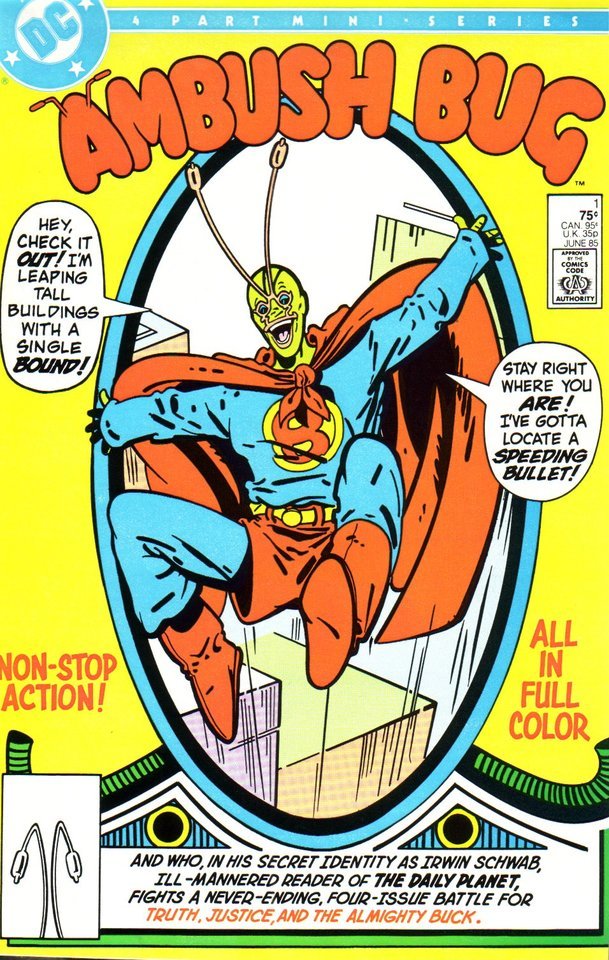
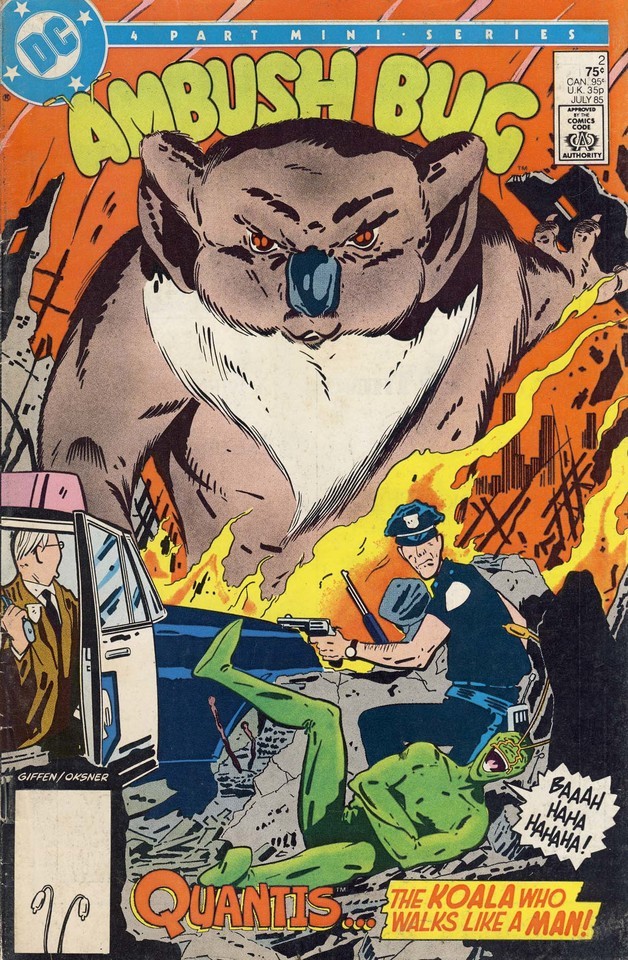

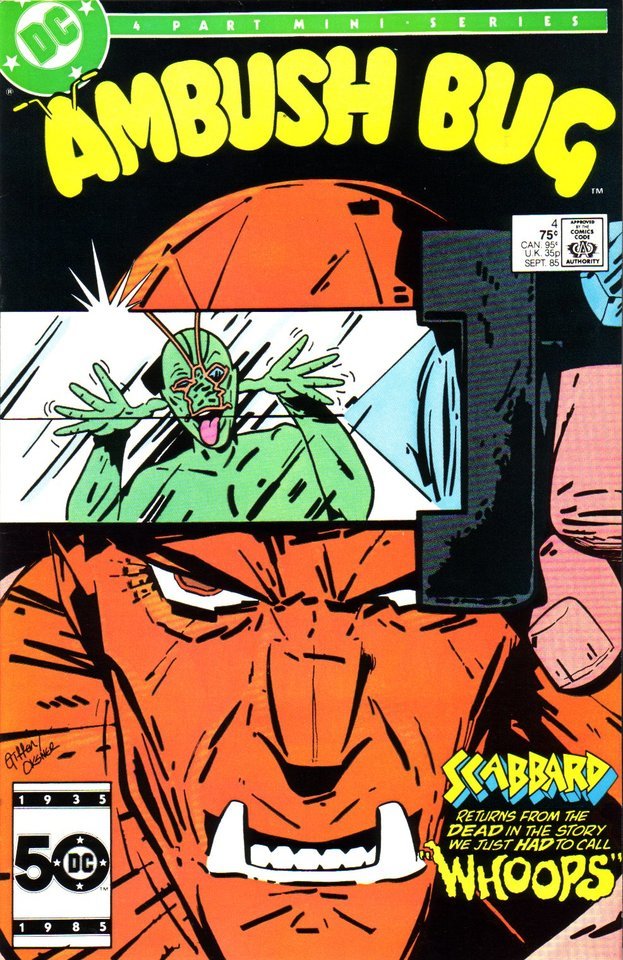
AMBUSH BUG #1-4
JUNE - SEPTEMBER 1985
BY KEITH GIFFEN, ROBERT LOREN FLEMING, BOB OKSNER AND ANTHONY TOLLIN
SYNOPSIS (FROM DC DATABASE)
The story begins with a giant alien space ship about to invade Earth, everyone is in a panic! But wait, wait, no, it's all a marketing plot to get people to buy Ambush Bug #1 and it works as the first issue sells out. Meanwhile, at the Ambush Bug Detective Agency, Ambush Bug is surprised when his old psychiatrist Derwood Denton stands up for him on national television. Just then a garbage truck hits a bump and one of it's contents falls out and smashes through Ambush Bug's windows. Investigating, he finds a toy doll with big cheeks, thinking it's a real live boy, Ambush Bug decides to adopt it and make it his ward and sidekick, naming it Cheeks the Toy Wonder. The Bug then dresses himself and Cheeks up in super-hero costumes and go about the city looking for crimes to bust.

While at a warehouse, a group of terrorists who are against Democrats have taken their grandmother hostage (She did vote for Jimmy Carter..) and plan on blowing up the warehouse (which is full of a lethal nerve gas) and the police have the place surrounded. When Ambush Bug spots the scene, he decides to try and save the day. As the Bug secrets himself into the building the police are informed that the terrorists have bungled and got the wrong warehouse.
Inside, Ambush Bug manages to throw off the criminals and confuse them by using Cheeks as a decoy. When the leader of the terrorists realizes that he is afraid of a doll he kicks Cheeks aside making of his button eyes fall off. Furious, Ambush Bug chases the ring-leader to a sporting goods store where he beats him up with a baseball bat. As Ambush Bug defeats the last of the terrorists and saves the grandmother, he leaves Cheeks behind to defuse the bomb. Of course, Cheeks is just a doll and so the bomb goes off "killing" Cheeks.

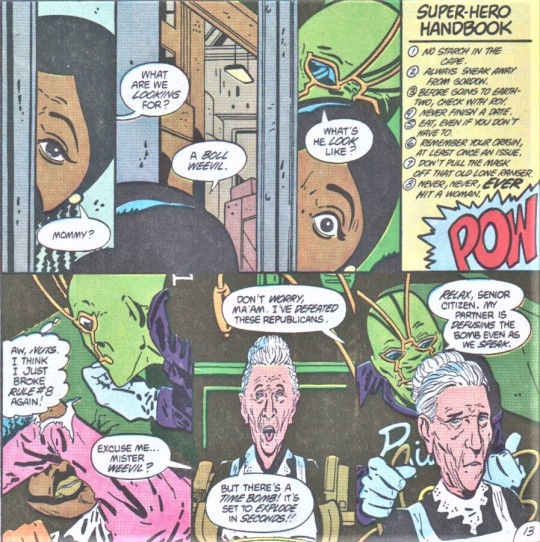
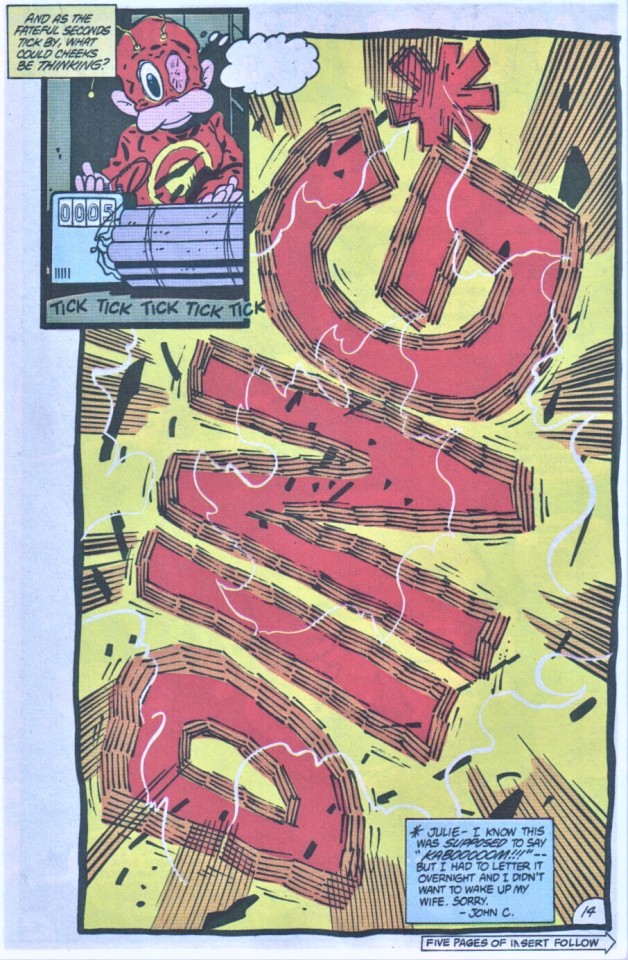
Just then, the story is interrupted by Peabody, Dicker and Pending who are revealing a new line of Ambush Bug promotional items for the consumer: The Ambush Bug Aerobics Physical Fitness Work Out Book for People, An Ambush Bug data sheet, Late Night: A horror novel by Ambush Bug, and a funny strip called Little Bug (wherein a child Ambush Bug is looking forward to Nuclear fallout, but then has to spend the next day shoveling it out of his mothers driveway.)

Getting back to the story, Ambush Bug turns over the terrorists to the authorities, and then holds a funeral for Cheeks. In mourning, Ambush Bug is then visited by his Guardian Angel who gives him words of advice: dead super-heroes sell comic books. Reinvigorated and excited about he success of his first issue, Ambush Bug decides to celebrate the death of his sidekick by ordering a pizza, and walks back home thinking up various euphemisms to get over the loss of Cheeks.

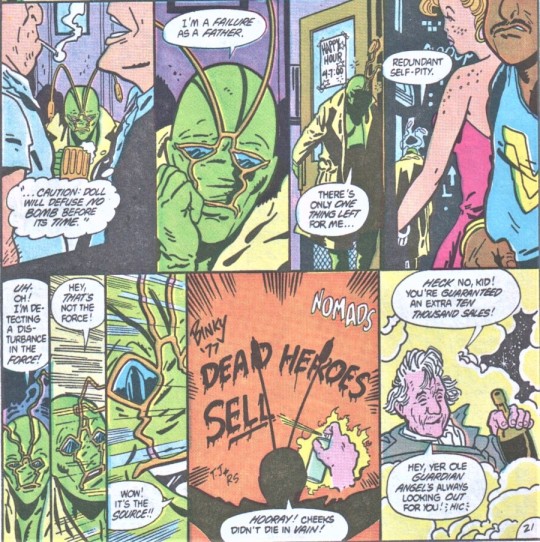
When he gets home, Ambush Bug is shocked to find Darkseid is waiting for him in his apartment.
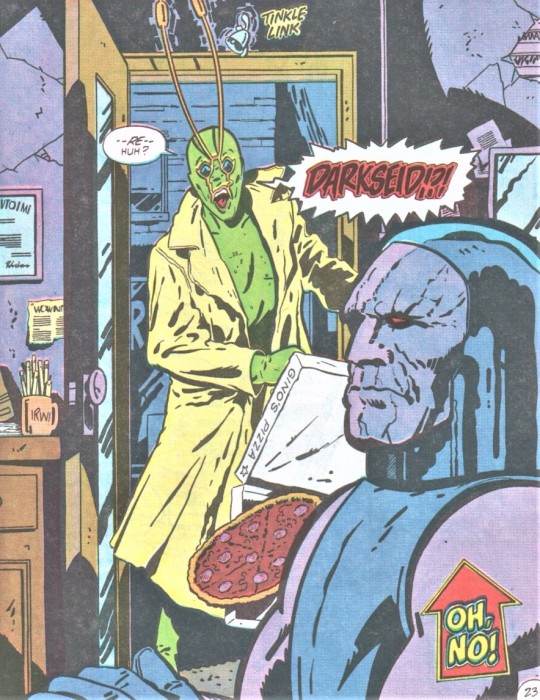
Our story begins in the apartment of Jonni DC, keeper of continuity in the DC Comics Universe, she is not impressed when a during radio report about the latest exploits of Mr. Mxyzptlk, they call him Mr. Mxyztplk (his Earth-Two counterpart), it's just another day in the life of the keeper of continuity.
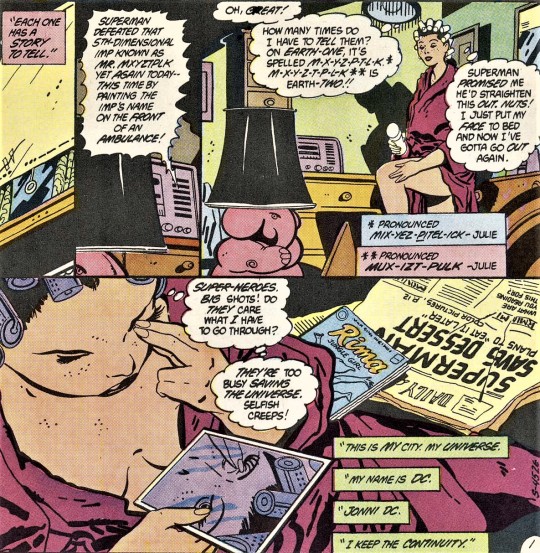
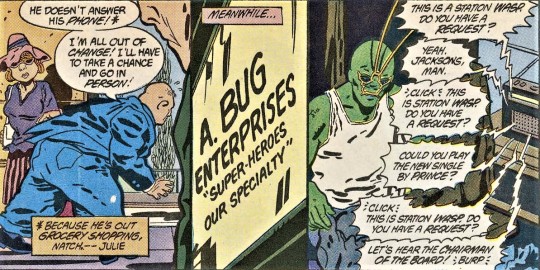
Meanwhile, a desperate janitor seeks the services of Ambush Bug and interrupts the Bug while he is taking a shower. The janitor tells the Bug that he worked in the cuteness wing of the Paddywac science lab. There, scientist Quentin Quantis was trying to isolate the cause of cuteness, using Koala's as a source to extract it from. Isolating the enzyme, he ingested it and slowly became Quantis, a giant Koala who walks like a man! Just as this bit of exposition is done, Quantis' foot smashes through the roof of Ambush Bug's office killing the janitor. Ambush Bug decides to do something about it, bit first an intermission.... The reader is shown the results of the "1985 Gnatty Dresser Awards" showcasing Ambush Bug in different outfits, and then presented with The Ambush Bug Guide to Collecting Comics.
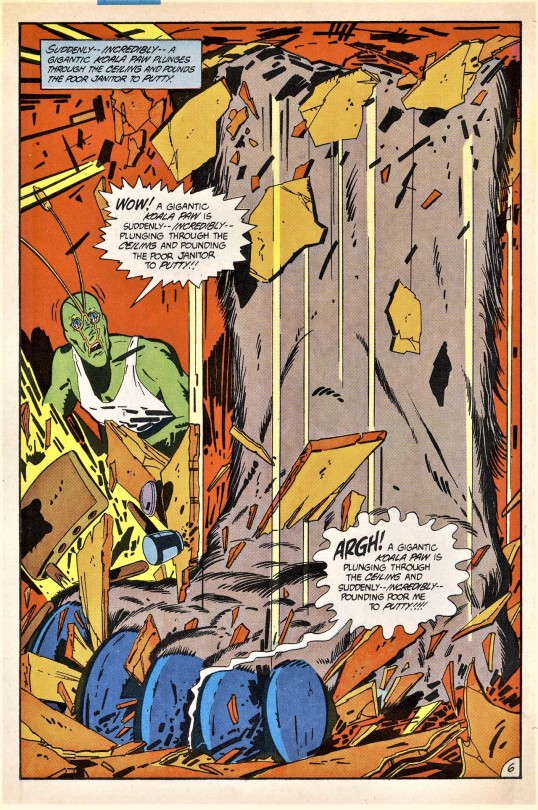
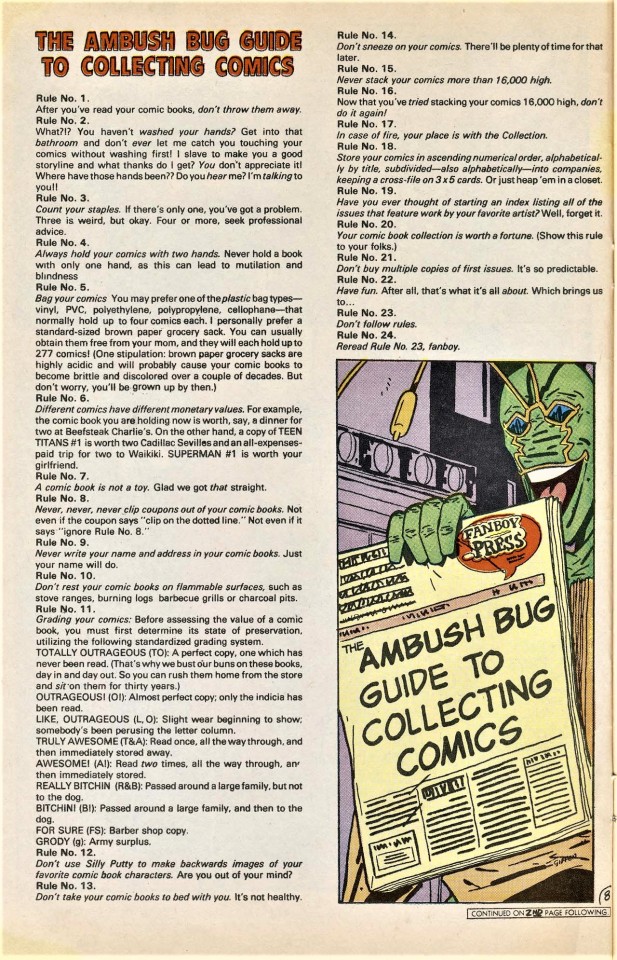
Back to the story... As Quantis rampages through Metropolis, the creature draws the attention of Jonni DC, who changes into keeper of continuity form and tries to stop Quantis because he will mess up continuity. However, she is no match for the creatures cute sneezes and Quantis attempts to play golf with her. However, this development of the plot is far too absurd for DC Comics Editor Julius Schwartz and he has Keith Giffen and Bob Flemming pull it from the story.
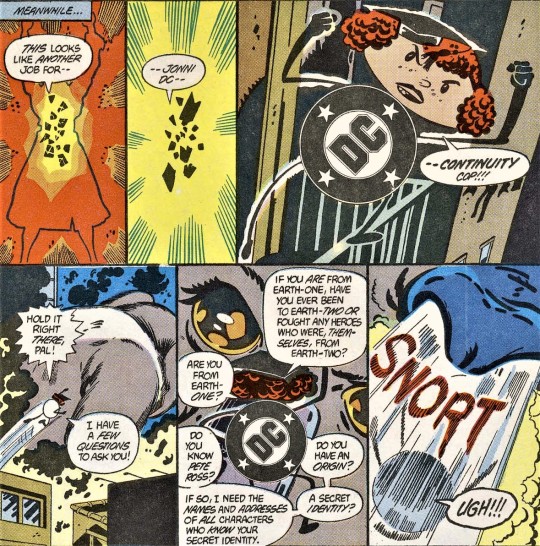
With the police ineffective against Quantis, Ambush Bug tries his hand at trying to stop the creature with minimal success and ends up being swallowed by the cute terror. Inside the creatures stomach, Ambush Bug meets Dr. Bagel and his wife who were eaten by Quantis earlier. They tell Ambush Bug of an antidote back at the lab, and the Bug teleports out of there to get it.
Ambush Bug then gets the antidote, but before he can administer it Giffen and Flemming cut back to Quantis trying to play golf again with Jonni DC much to Schwartz's annoyance. When the story gets back on track, Ambush Bug administers the antidote turning Quantis back into his human form, and he is knocked out by Jonni DC (who was finally hit by that damn golf playing Quantis -- Hey, did you expect this story to make sense or what?)
With Quantis defeated, Ambush Bug decides to go get some fast food, and is horrified to find that the person serving him is none other than.... Darkseid!

Ambush Bug decides to take this issue to give the reader his own tour of the DC Comics Universe, taking time to point out some of the more forgettable character of Pre-Crisis DC Universe. He reminds us of Egg Fu's appearances in Wonder Woman, and the forgettable Wonder Tot character. He then begins a detective mystery trying to find out where certain characters in the DC Universe had gone, starting with Binky. He interrogates some of his friends and colleagues and learns that he possibly ran off with a girl from Earth-Two. He later reminds us of Super-Turtle and the very annoying Aquaman back-up character Quisp and informs us of their mysterious disappearances.
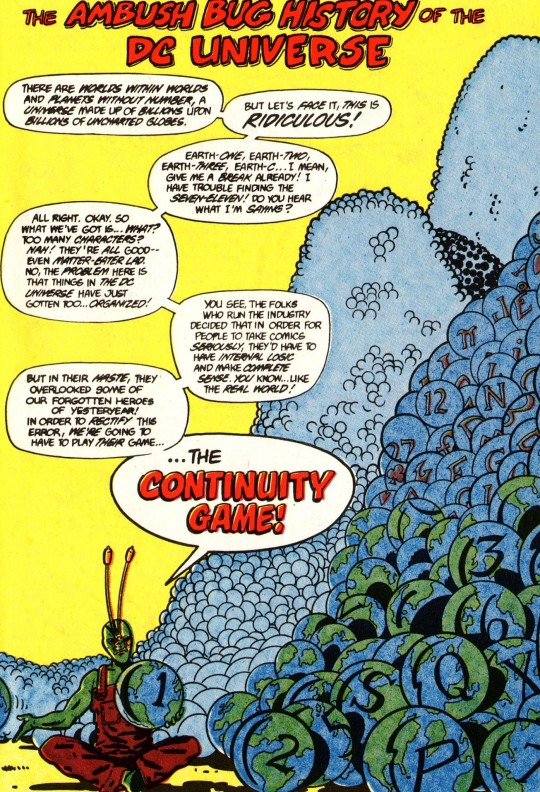
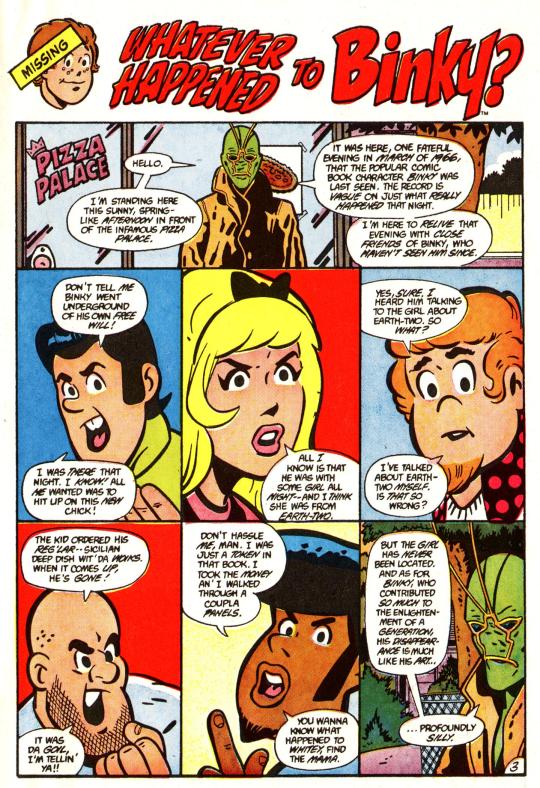
We're next shown two actors (Hembeck style) pretending to be readers of Ambush Bug hoping to learn Ambush Bug's secret origin in this issue, however Ambush Bug calls them on their true roles and goes back to the his investigation. He writes an ode to the Super-Pets Krypto and Streaky to the tune of popular songs, and then takes a moment to have a laugh about Super-Monkey and Comet's convoluted storyline. After meeting with the Green Team, Ambush Bug then writers a report about Cheeks and Itty, the Green Lantern's embarrassing and thankfully short lived animal side kick. Ambush Bug next meets with Bat-Mite who complains about the sudden changes in Batman's character from the campy caped crusader to the gritty dark knight with a reaaaalllly long cape. Ambush Bug is surprised that Bat-Mite has shacked up with Star-Mite instead of Batgirl-Mite.
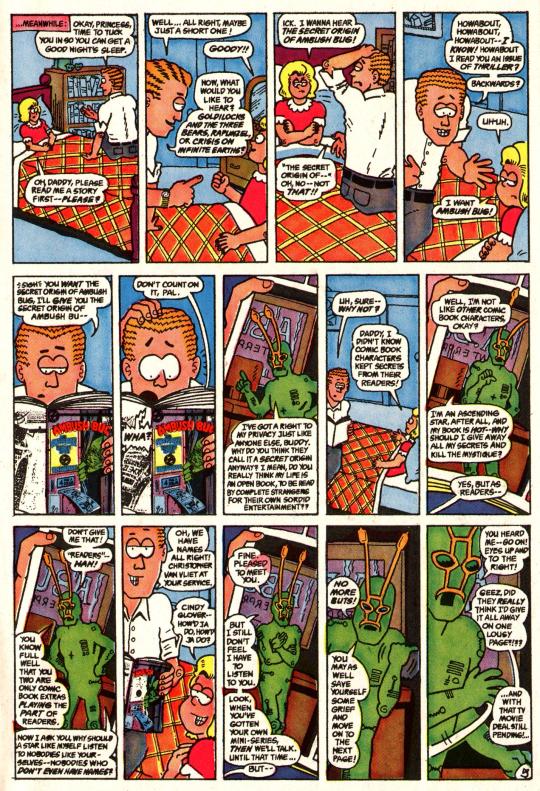
The story is interrupted with an intermission where we are given a science lesson about Superman's powers, a feature called "Ambush Bug Around the World" and a "How to Draw Ambush Bug" with a great teriyaki burger recipe, a "What If" about if the deadline couldn't be met how the story would go if another writer took over (such as Jack Kirby, Ernie Colon, Frank Miller, Steve Ditko, and Gil Kane), and a order form from the Ambush Bug Mart.
Continuing his quest to find missing DC character, he wonders about what happened to Cyrll and Doodles Duck, and learns that the House of Mystery has been put up for sale. After his search is interrupted by the Inferior Five calling Ambush Bug on the fact that they ripped off their concept, the Bug laughs about Ace the Bat-Hound, and makes a comment about Julius Schwartz, and when Schwartz wants a fight scene, Ambush Bug is only happy to comply and give people an instruction on how to draw comics in a grid.
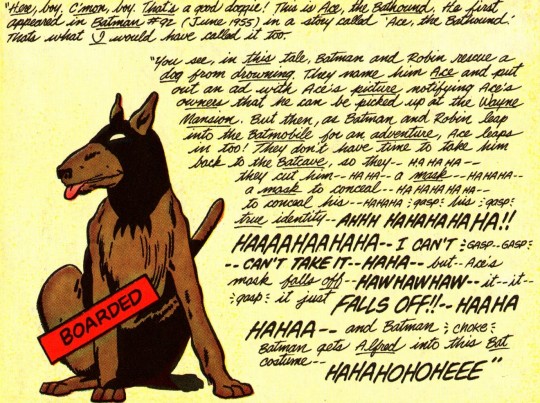
Back to the story, we learn that Mopee an obscure Flash character who claimed to be responsible for the Flash getting his powers is also taking credit for having a hand in every popular DC characters origins. After a visit to Bizarro World where Bizarro Ambush Bug is tormented, Ambush Bug muses about the Glob and finally learns the culprit to all these disappearances: Jonni DC, who's job it is to clean up DC community, however she is incinerated by.... Darkseid!
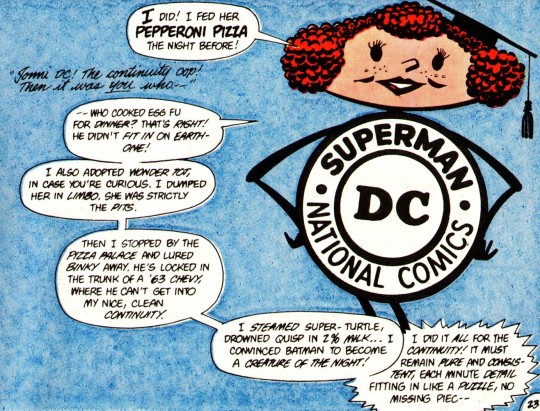
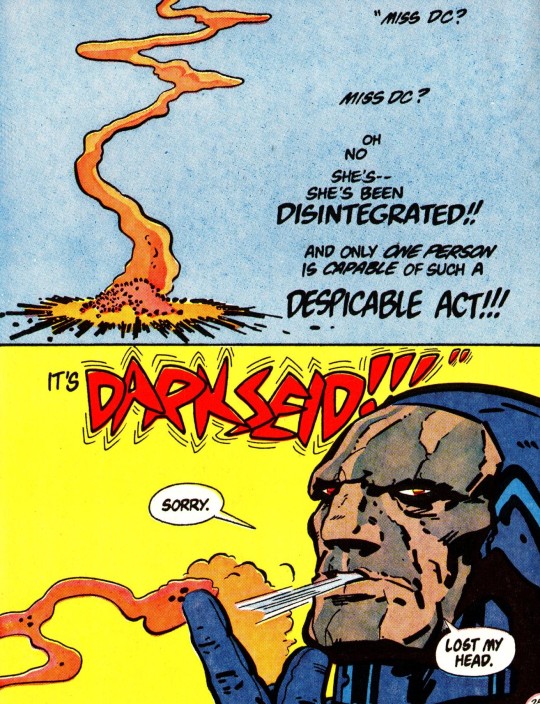
After a brief introduction into the Ambush Bug family where we meet Ambush Bug's family, which apparently consists of real ambush bugs, we cut a local police precinct in Metropolis. Here the villain known as Scabbard comes back from the dead and reclaims his head, which is being used by a police officer as an ashtray. Scabbard then goes off to get revenge against his foe Thriller. Scabbard instead runs into Ambush Bug, who is out for sushi, and frightening all the customers with his disgusting stories.
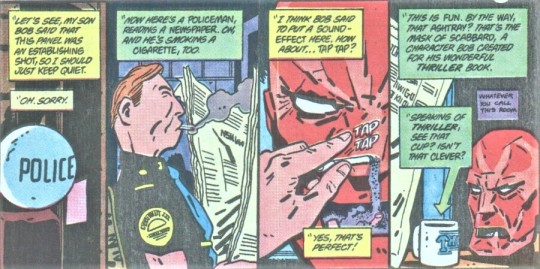
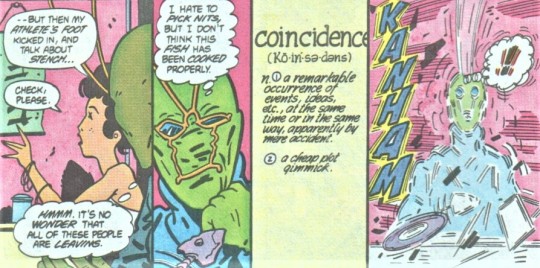
With everyone afraid to confront Scabbard, and with the villain hopelessly lost, Ambush Bug decides to take him on, but first reads up on Scabbard by reading a back issue of the comic "Thriller". Dawning a crude fencing costume, Ambush Bug battles Scabbard (with artist assists from Keith Giffen's son) eventually Scabbard realizes that he's in the wrong comic book, stops the fight, apologizes and walks away from a confused Ambush Bug.
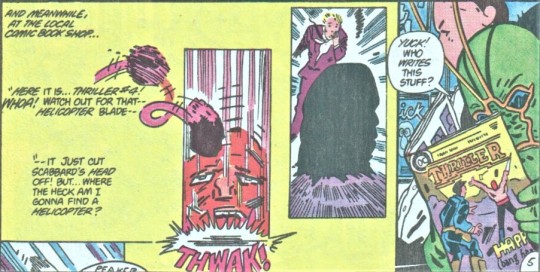
Realizing that they have more pages to do for this issue, the Ambush Bug creative team panic to come up with ideas on how to keep readers hooked. The best they can come up with is the "Death of Ambush Bug" however, the Bug refuses to participate in such a pathetic attempt to boost sales. Coming up with a new idea, the plot progresses...
While doing laundry, Ambush Bug notices that one of his socks is missing and thus begins a search to find this and other missing socks. He eventually stumbles upon a conspiracy orchestrated by Argh!yle, an animated sock that apparently came from the same space ship that was bitten by a radioactive space spider and contained Ambush Bug's uniform. The sock's pair being destroyed in a crash, and it gaining sentience from the radiation, the sock soon found itself abandoned and lonely. Hitting rock bottom finding solace in bing drinking until it was savagely attacked by a cat. Surviving and creating an iron mask, the sock, now calling itself Argh!yle, had built a giant bureau in space and began to use advanced technology to reanimate odd socks and recruit them in an army to get revenge against Ambush Bug.
Sending his minions after the Bug, they capture him and bring him aboard the bureau, where they use the device the "Balluptatron" to twist Ambush Bug up into a ball and launch him back to Earth. It doesn't kill him, but boy was it embarrassing. After a brief interruption to see the Ambush Bug family tree and a pin-up of Starfire, Ambush Bug throws a wrap party to celebrate the final issue of his first mini-series. He reveals to the reader that it wasn't Darkseid that was used as a cliffhanger each issue, but an inflatable replica.
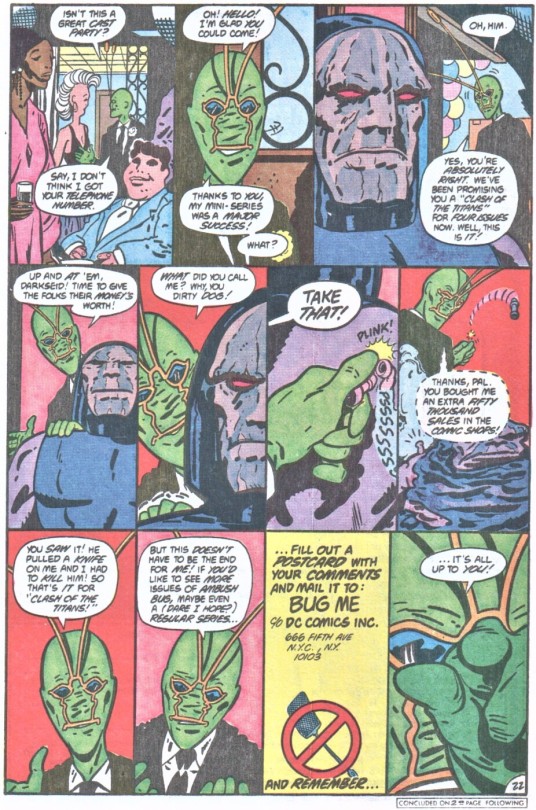
REVIEW
Ambush Bug is always an unexpected reading. Full with meta-jokes about comic-books and DC comics. But it doesn’t stop there, it also manages to insert some political “absurd” humor.
It helps a lot to read titles where Giffen and Loren Fleming were involved. Most obviously “Thriller” which I couldn’t finish reading because it was to hard to read. Well, they trash that title over and over in each issue. And the Darkseid insert is a joke about the Great Darkness Saga, and how Darkseid was teased and postponed until the last issue.
It also makes fun about dead sidekicks bringing money to the publishers... and this was before the death of Jason Todd! (the cemetery is named Barnes, after Bucky).
It has hilarious moments, like Cheeks not being able to diffuse a bomb. It’s comedy gold.
Even the letterer has some fun with the captions. It seems like this was a full-team contribution.
I give this story a score of 10
#dc comics#comics#review#keith giffen#bob oksner#ambush bug#jonni dc#cheeks#darkseid#1985#modern age#humor
13 notes
·
View notes
Note
"first kiss" (KirFluff)
“First Kiss, or Don’t Take Kissing Advice from Bad Romance Novels”
What Kirby knew of kissing came from Susie Haltmann’s romance novel collection. The former secretary had taken up residence initially in Dreamland’s castle after the defeat of Void Termina, but recently, she’d spread out and set up shop in another corner of Dreamland, where she was working to rebuild her father’s company. Minus the colonization. Or so she said. Kirby believed her; Meta Knight didn’t.
And as the secretary had left, she’d flipped her hair with a hand and handed Meta Knight a book. “For you, Sir Knight,” she’d said.
It had–apparently–been a very raunchy romance novel about a secretary and a knight. Kirby hadn’t gotten to see it, but when he’d looked at the book and then at Susie, the secretary had rummaged through her novels and produced one. “For you, Pinky,” she said, and shooting a glare at Meta Knight, “It’s clean, Sir Knight. Don’t worry.”
And once Kirby had gotten older and learned to read and developed an interest in romance novels, he’d read it. And he’d thought about it. And he’d spent a lot of time thinking about it. And about Fluff, who–of the late–had made Kirby’s insides alight with butterflies.
It was time for the sacred romantic tradition of the First Kiss™. Step one. Cast lots of romantic looks in the direction of the object of his affections. Kirby went on the tips of his feet and did his best to gaze at Prince Fluff, who sat by the riverside and watched the tiny fish swimming by. Kirby widened his eyes and experimented with intensely gazing at Prince Fluff.
Fluff looked up. “Hi, Kirby!” he exclaimed.
“Hi!” Kirby chirped back.
So far so good. More intense gazing.
Fluff furrowed his brows together. “Are you all right?” he asked.
Evidently, too much gazing. “Yes,” Kirby said, sitting beside the blue puffball.
What was the second step? Flowers or heated, casual touches? Kirby frowned, and seeing a bright, yellow flower nearby, he plucked it from the grass and passed it to Fluff. “For you!” Kirby declared, his nerves making his voice come out in an embarrassingly high pitch.
Kirby had thought adolescence would deepen his voice, make it more like Meta Knight’s dark, dulcet tones, but instead, Kirby’s voice bounced between high-pitched and maybe a little deeper than when he was a child.
“Oh,” Fluff said, taking the flower in his paw. “Thanks, Kirby! I do like your Dreamland flowers. I mean, they obviously aren’t better than those in Patch Land, but they do have very bright colors.”
As Kirby dropped his paw, he made sure that it brushed against Fluff’s. Lightning shot through Kirby, lightning that had nothing to do with Copying Fluff’s talents and everything to do with touching Fluff.
“Are you…uh, all right?” Fluff asked. “You’re acting strangely today.”
Kirby felt his face warm, his cheeks doubtlessly brightening and making his embarrassment more apparent. His mind raced. What was the next step? Was it kissing? Hugging? Or did hugging and kissing come simultaneously?
There was a soft feeling, like a butterfly lighting on his cheek. Kirby leaned into the feeling. It took his mind a few seconds to catch up and realize that Fluff had kissed him. And once Kirby’s mind did catch up, it began short-circuiting. Fluff brushed his cheek against Kirby’s, rubbing their cheeks together. “Thank you, Kirby,” Fluff said, tucking the flower into his crown.
“Uh huh,” Kirby said.
Fluff’s brown eyes sparkled, even as his face reddened. He cleared his throat. “I hope you found that…satisfactory. I’ve not had any practice in kissing. Not that I need it, of course. I, Prince Fluff, must be very careful about displays of affection. There are many princess vying for my hand, and I wouldn’t want to–um–have them misinterpret my actions.”
“It was fine,” Kirby replied, his throat raw.
“Ah, perfect,” Fluff said. “I mean, of course, it was.”
“You should…” Kirby trailed off, trying to remember all the flirtatious words in Susie’s romance novel. “You should practice more, though. We should practice together.”
Fluff took in a sharp breath of air. “Yes,” he said, “Yes, I think we should.”
73 notes
·
View notes
Text
Read It For the Pictures 38: Avatar: Tsu’Tey’s Path by Duursema, Smith, Dzobia, and Parson
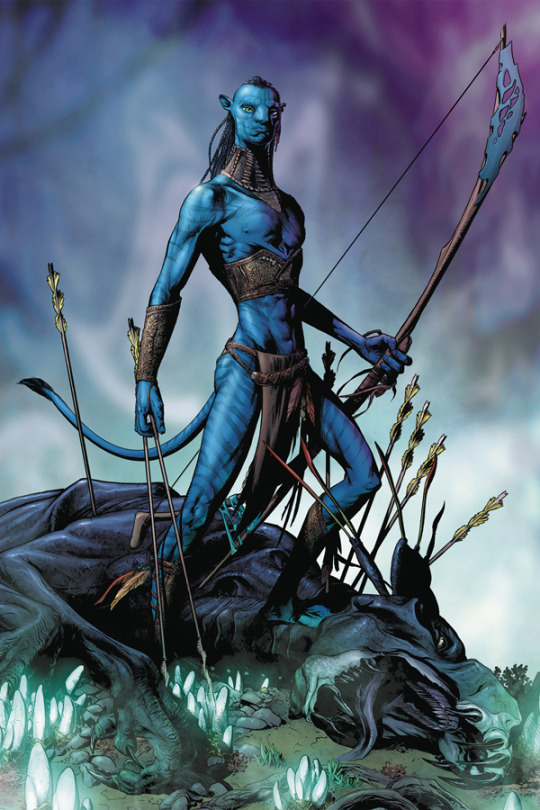
NK: Welcome to Read It For the Pictures, the comic book blog where we read it for the pictures! So, Dave Clarke, may I ask you what you were up to in 2009?
DC: I was at home watching television, so no I don't have any witnesses who can confirm that. And on that television I was seeing ads for James Cameron's Avatar. I didn't see it in a cinema, though; it would take another year or so for me to watch a DVD copy on the crappy little tv in my dorm.
NK: I.e. not in 3D, its big selling point
DC: Yeah, I didn't really get the appeal when I watched it. But in the spirit of the looking back 10 years and comparing the exciting, brimming with potential world of 2009 to the bloated and depressed pointlessness of 2019, we're reviewing an Avatar comic that came out this week.
NK: Avatar: Tsu'tey's Path #1 is a prequel comic written by Sherri L. Smith and illustrated by Jan Duursema with inks by Dan Parson and coloring by Wez Dzioba. It tells the story of Tsu'tey, the native heroine's betrothed who, following the "Pocahontas in Space" script, is just there to get cucked and get killed, so it's not like he's a complex and memorable character whose rich backstory we're worried about contradicting.
( Also, while I hate the regressive misogynist types who use the word, I really like saying "Cuck" because it's a funny sound. Cuck cuck cuck cuck cuck )

DC: Yes, Ive been hounded all week by Neil wanting to review the cuck comic. The year of the orc is over, long live the year of the cuck
NK: I was skeptical about this because the only other comic I've read drawn by artist Jan Duursema was a Wolverine "Prestige Format" one-shot in a fantasy AU Fortunately she's done a lot more than just ridiculously jacked grumpypusses in her long career.

DC: And how do you think this held up.
NK: About as well as it could've in a dimly lit forest with entirely half-naked blue cat people. So definitely points for accuracy.

DC: Yeah folks, not much to talk about in this one were you wondering what the blue aliens were doing prior to humans showing up? Pretty much just hunting and stuff
NK: Did you have trouble telling the characters apart?
DC: One was a woman

Pictured: a distinct and memorable cast of characters
NK: There was some impressive facial work in this comic in the scenes where characters got to emote beyond being stoic. It is worth noting that Avatar's Pandora is a beautifully designed world with some extremely impressive creatures. The trees are impressively organic and create a nice environment
DC: Neil was always a better diplomat than I. The biggest hint, to me at least, that this wasn’t a passion project was that even the action scenes seem to have no attempt at foreshortening. (foreshortening is when you draw a long object, like an arm or leg, distorted in such a way to look like it's coming towards the viewer, creating the illusion of depth)

NK: A lot of these are fairly stock superheroey poses too.

DC: The mighty marvel method allowed Jack Kirby to infuse page with a dynamic and spontaneous energy and also allowed people to easily crank out tie-in comics to 10 year old movies no one cares about. A few action poses, a few meaningful looks in a conversation scene, fit the words around them
NK: Computer coloring only goes so far to enhance this, comics haven't benefitted from technology to compensate for flat story as well as movies or games
DC: Come to think of it this probably went through several layers of approval from the IP owners. I wonder who has the job of making sure that the clothing the na'vi wear across multimedia is consistent.
NK: I would've preferred they gone with a radically stylized look to showcase the Na'vi's movements being far more fluid and flexible than humans'. For example, a Ted McKeever Avatar

DC: Michael Fiffe's Bloodstrike: Brutalists which we reviewed a while back is the good version of this decade out of date revival done right.
NK: Yes, that is a much better way to revitalize a long dead franchise the world's long since forgotten
DC: I wonder if any of the kids who saw avatar at a formative age are old enough to be nostalgic for it while the Na'vi go through a Shrek style ironic revival?
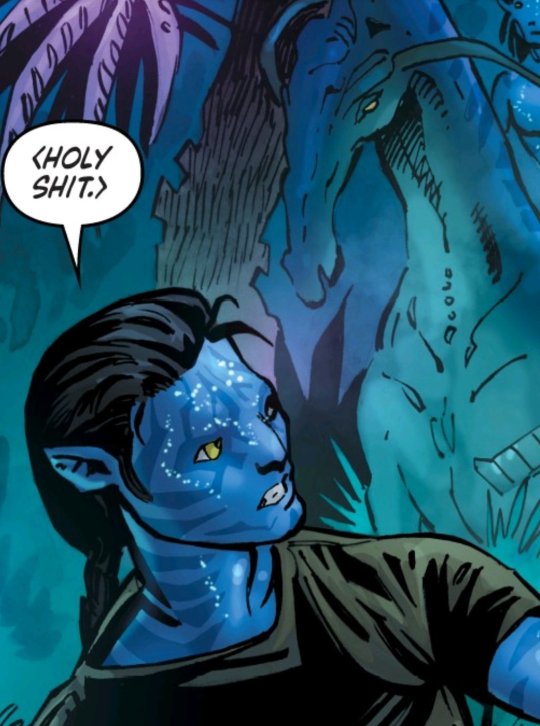
NK: In theory I like the idea of telling the story of the Na'vi, a mash-up of indigenous cultures through the lens of a rich white guy's philanthropy, from the perspective of the actual natives
DC: Weirdly this comic, by mostly just being the natives fucking around doing their own thing, has less weird politics than the film, where the white outsider was the hero in a story about pushing back the colonizers
NK: Avatar is really a form of colonialism that, having exhausted the natural resources and human labor it brutally stole from the rest of the world, shows it sympathy it can sell in the form of a #NotAllWhities adventure.. The bar is so low for larger sociocultural consciousness in Hollywood films that it almost seems woke compared to, say, the Transformers movies At least this comic gives Tsu'tey another note or two to his personality beyond "Cranky Cuck".
DC: What note was that? I mean, I know what it was, I’m asking for the readers. Obviously.
NK: That he's still mourning the death of his true beloved, Ney'tiri's sister, and he's stepping up to roles set before him.
DC: Let this be an PSA to fellow content producers: reviewing an Avatar comic in 2019 is not the easy comedy goldmine it may seem at first glance. That said, are you excited for Avatar 2: the search for Na'vi's gold?
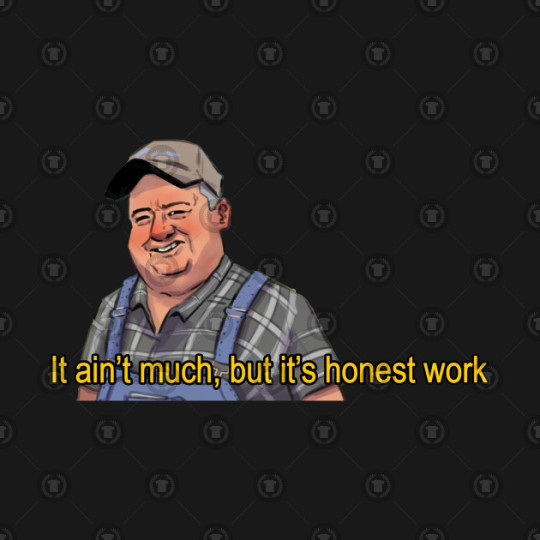
NK: If you'll excuse me, I gotta go fast to catch a ship that sailed years ago.
DC: At least spending $4 on a comic for ironic nostalgia is cheaper than spending $20 on a movie ticket. Anyway, happy new year everyone, we promise* to have more regular reviews this year
*not legally binding
11 notes
·
View notes
Text
ART4002 - Reading The Landscape
What are the key uses of field notes? Why are they a useful tool in research?
In the text ‘Reading the Landscape’ the author explains that ‘field notes’ are best used to ‘formulate questions’ upon reflection of a detailed on-site description record. This is evidence of our natural inclination to draw upon our interests through observation. Furthermore, the author explains how this method has informed the writing - ‘I have returned to the notes and the interview material and worked to make the findings plausible.’
David Linton’s view couldn’t resonate more with the illustrator. He argues ‘that there is no better way of becoming seized of the characteristic features of any landscape than by sitting down and making a drawing of it.’ Essentially, it challenges the visual artist to understand what they are looking at.
In an effort to become a better observer, I have intensified my drawing practice by attending Aldis’ Life drawing classes, visiting exhibitions and exterior locations of interest. Concurrently, whilst having a clear-out this week, I stumbled upon an old class sheet titled ‘Da Vinci’s 9 Sketching Exercises to Achieve Artistic Mastery’. It seemed a perfect way to apply the field text’s ‘interpretation methods’ of research, to the field of art. This ancient list will serve as the blueprint for my approach.
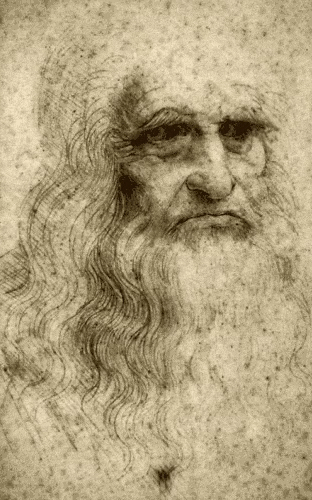
What does the text indicateas the key issuesin interpreting and manipulating visual imagesas part of your research?
The section ‘Interpreting and Manipulating visual images’ within the text addresses the many ways in which images are produced and manipulated in the digital age. Whether personal or commercial, the capturing and editing of an image effects both the composition of the physical outcome, and our perception of reality.
Most notably, in 1982 Gordon Gahan’s National Geographic magazine once sparked controversy by ‘retroactively repositioning’ a cluster of pyramids in a cover picture. A prime example that digital imagery is always open to manipulation.
Within the illustrative process, narrative images are by and large, drawn with the hand as opposed to photographed. There is therefore less restriction on realistic accuracy as the drawn image is the craftsman’s original. It represents both an extension of the artist’s viewpoint, and a distinct language for a story.
The job of a narrative illustrator is to compose a drawing using visual devises effectively to design something new, not familiar.
How might the interpretation of visual material be pertinent to research in your own field?
The artist who is pursuing the creation of a graphic novel is free to explore as many reference photos as is necessary to inform and build the desired visual narrative. For instance, In the case of my Final Major Project, we follow our main protagonist through a traditional vendetta story that is set in a cybernetic universe.
In order to inform the visual language and design for such a place, I have collected many images of both primary and secondary photos for rough drawings. For environmental structure and world-building, I take local photos of architecture, machinery, vehicles and industrial technology.
Regarding character design, my organic section mainly consists of human facial and bodily features, outfits, animals and natural landscapes. All of these elements feed into the visual design process. Furthermore, secondary inspiration is drawn form other artists such as Moebius (science fiction) and Andrew Loomis (anatomy). A conscious effort is made to selectively adopt some desirable aspects of their work into my own work. Whether to visualise colour, line weight, art mediums or even overall style, a master’s work is always useful to look at.

Pages 124-126 describe the use of found images in a research project that used postcards from Paris as a means of investigating the connections between France and Algeria during the era of French colonisation. Can you think of a research use for found images in your own discipline? Briefly outline a possible research project of your own that makes use of found images.
In the research project investigating the connections between France and Algeria during the era of French colonization, the author states that sourcing ‘images does not necessarily require ‘fieldwork’ as they can also be gathered via the internet, libraries and archival and desk space research’. In fact, my field requires a mixture of both.
When creating any believable narrative, collecting a range of interesting historical photos, objects and organic forms on-site can help to inform the creation of a tactile and believable reality. For instance, in my current Final Major Project, there are many action sequences, which require fight and motion references. To inform my depictions, I collect 1960s Jack Kirby comic books, old photos of Edweard Mybridge’s motion studies, and pose-able figurines. These are then photographed or drawn directly into my composition.

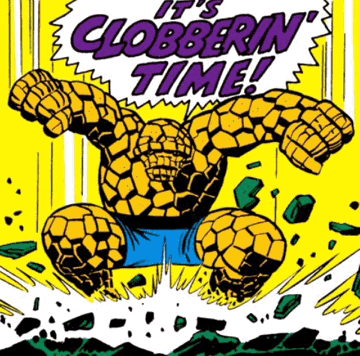
Pages 133/134 outlines the use of soundscape recording within a researchproject on the social divisions between the daytime and nighttime inhabitants of downtown Edmonton, Canada. Can you think of a research use for soundscapes and/or smellscapes in your own discipline? Briefly outline a potential research project of your own that makes use of these textured layers of recorded sound or smell in the environment.
On page 133 of the text, the social divisions between the daytime and nighttime inhabitants of downtown Edmonton, Canada could not be more contrasting. The pedestrians of the day ‘navigate the city without ever stepping into the bitter cold outside’ whilst at night ‘Shops were closed, food courts shuttered, but young people lingered, noisily in passageways and in-between spaces’.
Soundwalks such as these go hand-in-hand with all our other senses. To smell, taste, touch, see and detect with the nervous system are intrinsically connected when being present in any environment. Any believable story animates these senses merely through the sequence of visual imagery. A narrative story often displays a deeply convincing environment with certain personalities, buildings and atmospheric elements that seem to ‘belong’. By kick starting the imagination, the illustrator helps the reader to animate their senses when reading. These are devices that help bring the comic to life in a magic way.
In order to achieve such effortless and enjoyable readership, experiments which incorporate drawing, descriptive writing on visual, smell, taste, touch, sound and intuition could be undertaken in both Central London and my suburban hometown in Hertfordshire. I predict that the contrasting results can aid the understanding of how to depict a shift in mood or atmosphere from one scene to the next.

2 notes
·
View notes
Text
‘Change Your Mind’ was a fun, messy anime hoot ‘n holler, I reckon. Is it my favorite episode of the season? Nah, that’s a different episode that I don’t wanna spoil. Is it the best episode of the arc? Nah, that’s still Escapism. But nevertheless, there is quite a lot to unpack that I wanted to express and if I did a play by play of this 44 minute special, we’d be here for several hours and nobody got time for that. And if I continuously jabber on about this in spaced out posts, I’d feel more like a SU Critical blog than I typically am and that’s pretty depressing. So, I’ve packed all my stray thoughts into one package to get it out the way. Spoilers ahead.
Small headscratch, but I question why it’s notably four episodes on the wikis but it’s essentially one episode and should count as one episode. Can’t really see one part without understanding everything else so I’m a bit confused. Then again, I’m not that encyclopedic on media production so it’s no big deal.
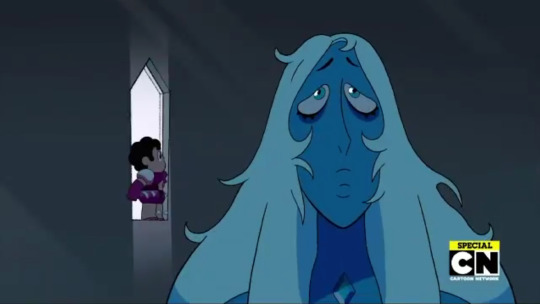
I liked Blue Diamond in the first part and this arc as a whole. In spite of who she generally is, Blue was a consistently good character in that her regret and more motherly nature never felt out of place compared what we’ve seen of her initially because her devastation over Pink’s “death” never felt superficial and the times when she got serious were eyebrow raising to me. And her turnaround in this felt reasonable compared to the others for she thought more of Pink/Steven beforehand and looked like she was more aware of how times have truly changed, even when the allusion to abusive families fall flat.... you know, if we were thinking realistic. Eh, Blue best Diamond, if that means anything.
I question why Yellow had what appears to be forced fusions or genuine crystal amalgamates if Diamonds were against fusion. I understand the ones on Earth, but why was she keeping them, probably for some time now, if she has no use of them? Again, maybe they’re born crystal amalgamates. It’s unclear.
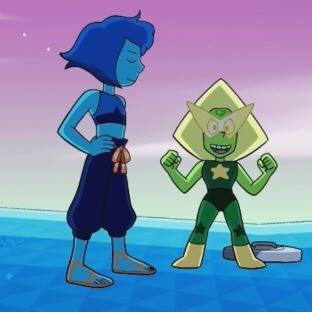
I would say deep down I felt cheated that Lapis and Peridot are apparently cool now even when Lapis took everything in the divorce and did the reentering parallel to an Irish goodbye. But I guess dropping the barn counted as an act of apology, and maybe we’ll see them interact more in the future, so plbbt. At least they got to be badass and anime together while looking the part too.
In the back of mind, I forgot that Bismuth was in the episode sometimes. Beyond giving Connie her sword and raking up that star punch, I can’t say she added much to the story.
Speaking of which, wish the Diamond’s Pearls got to partake in kickassery of the sort. Homeworld was surprisingly empty in hindsight.
Loved Rainbow Quartz the 2nd. He’s beautiful and I would gladly get strong for him.

Only one thing bothered me about Sunstone, aside from the sunction cup summon. and it’s with their small arms. I thought those big arms were more for her shapeshifting since Garnet’s known to shapeshift her limbs to be enormous, but they’re always big so... what value do Sunny’s little arms serve? Least with say, Smokey Quartz or Malachite, their multiple limbs added to their ability but Sunny’s two beefy arms carry most of the way. It’s like adding two dormant legs to the side of a grasshopper. And seriously, what was the point of the suction cups.
Though I love Monty Python reference they added in. That got a huge laugh outta me.

Obsidian was a spectacle, being the first genuinely naked human gem of the series, and the design reminded me a lot of Asura’s Wrath. Though one small detail I wish they had was where Obsidian’s fingers dug into the mech, leaving large dents on the ship, which would’ve hit home the struggle of getting to White as opposed to somehow being able to grip onto the mech’s more or less smooth surface.
Overall I’d say the part between the Diamonds reconciling and finally reaching White was hit or miss if we’re talking writing. Like sacrificing logical flow more for providing the fan service isn’t nothing new, but time could’ve been utilized more for more to go on.
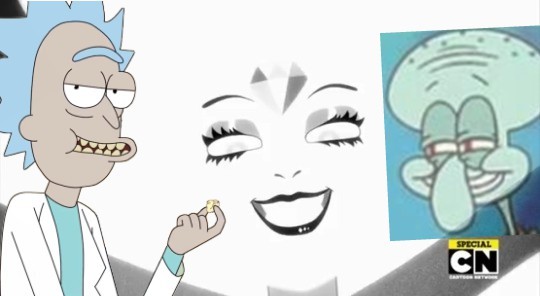
I couldn’t take White as a serious threat anymore, she was just too cheeky and Ebersole sounded like she was really enjoying herself with voiced. I just hope somebody dubbed Glados over her sometime.
Couldn’t take the moment where Steven got his gem ripped out either cuz as hardcore as that was, adding a sound effect sort of killed the tension for me and I laughed my ass off. I’m sorry.
But as much as I loved the scene that was well animated by veteran 2D animator James Baxter, I especially loved the scene where after Pink Steven forms, he turns to White and says, “You should’ve gone for the head.” Snapped his fingers and destroys Homeworld to finally end everyone’s suffering. Like holy shit, that was the best scene in the entire series, hands down.
Plus I like the idea that Pink’s gem... actually fused with Greg’s sperm. *wheezes* I’m the worst
As much I like the idea of White Diamond, having been told off by a child, reforming her viewpoint, being a less coerce being and making the family whole again, the fact that she’s still a mass murdering, mass torturing, mass colonizing, authoritarian Orwellian style villain rubs me the wrong way with how much of a 180 things turned out to be. It’s like if the Beaudelaire siblings immediately forgave and thought Count Olaf was a great person all along after he did that one good thing and then died. But I guess if Steven held White under a small lens of contempt, then it wouldn’t be Steven Universe. What also makes this feel hallow is that.... when you think about it, all this amounted to was the Diamonds doing Steven a solid. They don’t really quit being dictators, they never really claim that Homeworld should change its way, or think White should step down as leader thanks to her perfectionism affecting HW harshly. They’re just nice rulers now... like Kuzco except not as cool. This plot honestly could’ve fallen apart if White Diamond was more reasonable while still maintaining her villainous perfectionism. She was kinda stupid in a way but eh, whatever. Like yeah, she’s shiny... but she’s not
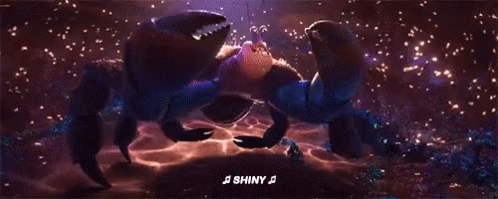
Then again, imagine White Diamond’s current position.
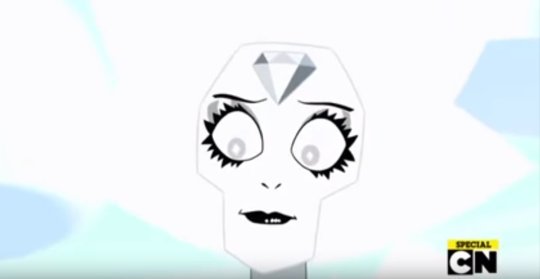
Imagine the sense of losing your entire worldview, ideology, and sense of self to a being the size of your big toe. Imagine everything you’ve built up, potentially taking centuries or millenniums to uphold to sheer excellence, all crumble before you in a instant. How would it feel? To lose your purpose and have nothing to show for yourself beyond your now shrill existence and status regardless of your stature, because you feel that if you were to try again, history could repeat itself but 10x worse. That small being that conquered you, could do it again if tempted and what would you do? What else would you do if you have some semblance that it won’t work out perfectly as before? What else would you do if you’re now capable of fearing something with which you don’t and potentially will never understand? You honestly don’t have anything now, you’re nothing now. So what could work out for you besides smile, wave off your loss with integrity, and feel comfortable knowing that you live another day while understanding now that any day could potentially be your last, given what you know.
You feel me? It’s like that.
And I’ll say that while the Diamonds suddenly having a change of heart can seem off putting, the fact that Steven went through all that shit with his real family just to do so is reasonably sound. Can’t say a redemption arc in the making ain’t all bad if the protagonist didn’t put in work as well. And if Naruto can forgive Sasuke after they beated each other’s ass, I feel that this ain’t too different.
“Change Your Mind“ was a good song, better than the new Crystal Gem extension. A nice cap on the sprite cranberry of an episode.
So it seems like this episode marks the end of Steven Universe. Now it’s time for Steven Universe 2. Because if this wasn’t anime enough... we’re gonna be time skipping, babey. Reasonable enough, this episode messy here and there but I have one counterargument to this, given that this show is five fucking years old.....
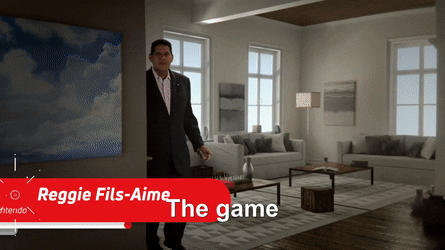
I’d be a bitter asshole if I said I didn’t genuinely enjoy this, both initially and on the rewatch. It is an all around entertaining finale and I’m glad it embraced the weeb trashiness in itself like I always knew it would. Funny thing about all this is that we’re going into hiatus and I’m willing to bet that excluding the movie, we’re gonna have the same amount of premieres as last year. But I believe the hiatus won’t matter as much since they certainly gave people quite the show and I can’t help but applaud along.
Now if ya excuse me, I’m off to marathon Kirby Right Back at Ya, an anime I believe is better than SU all things considered. Have a wonderful day.
4 notes
·
View notes